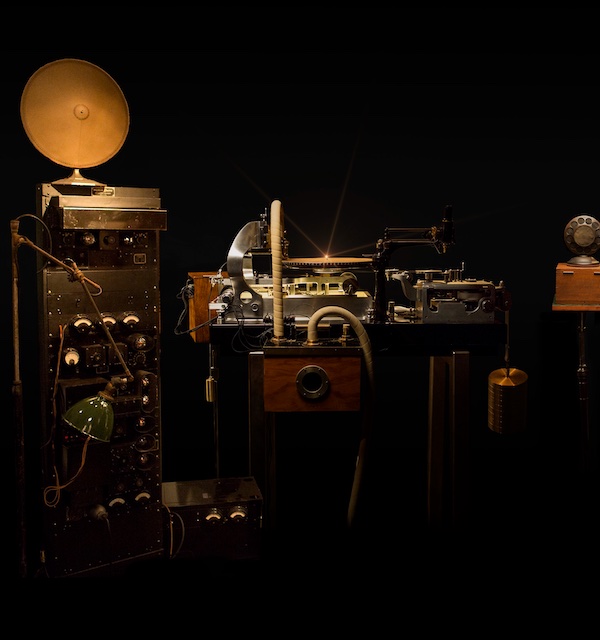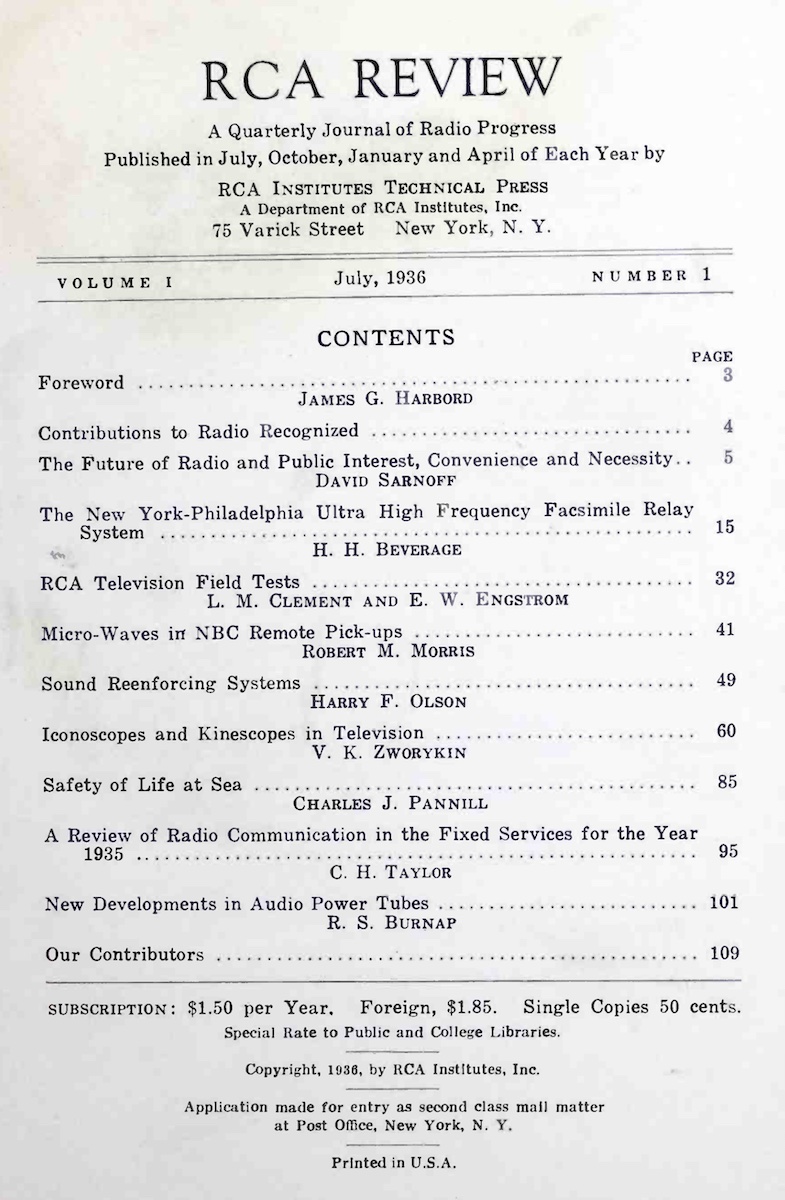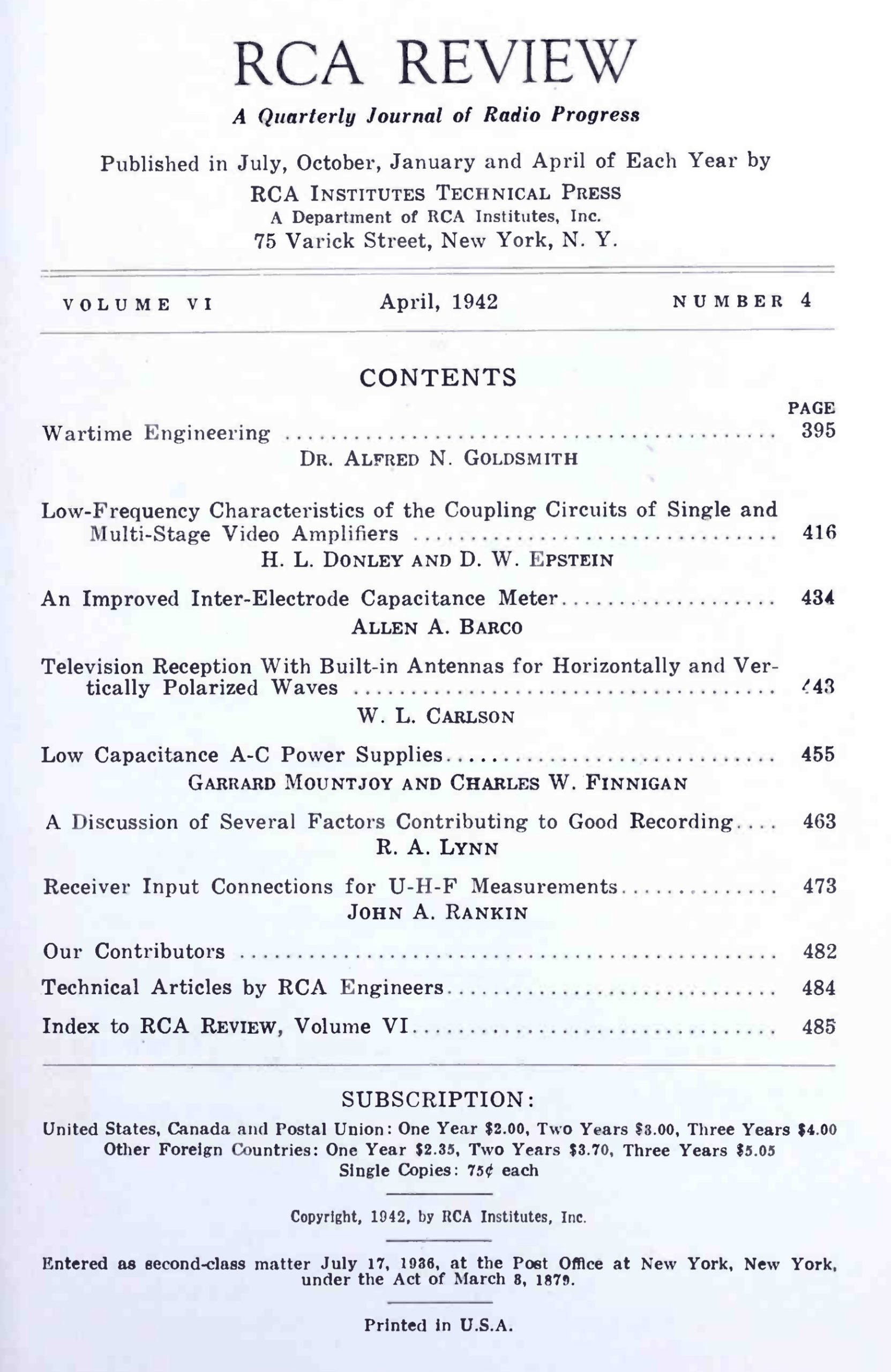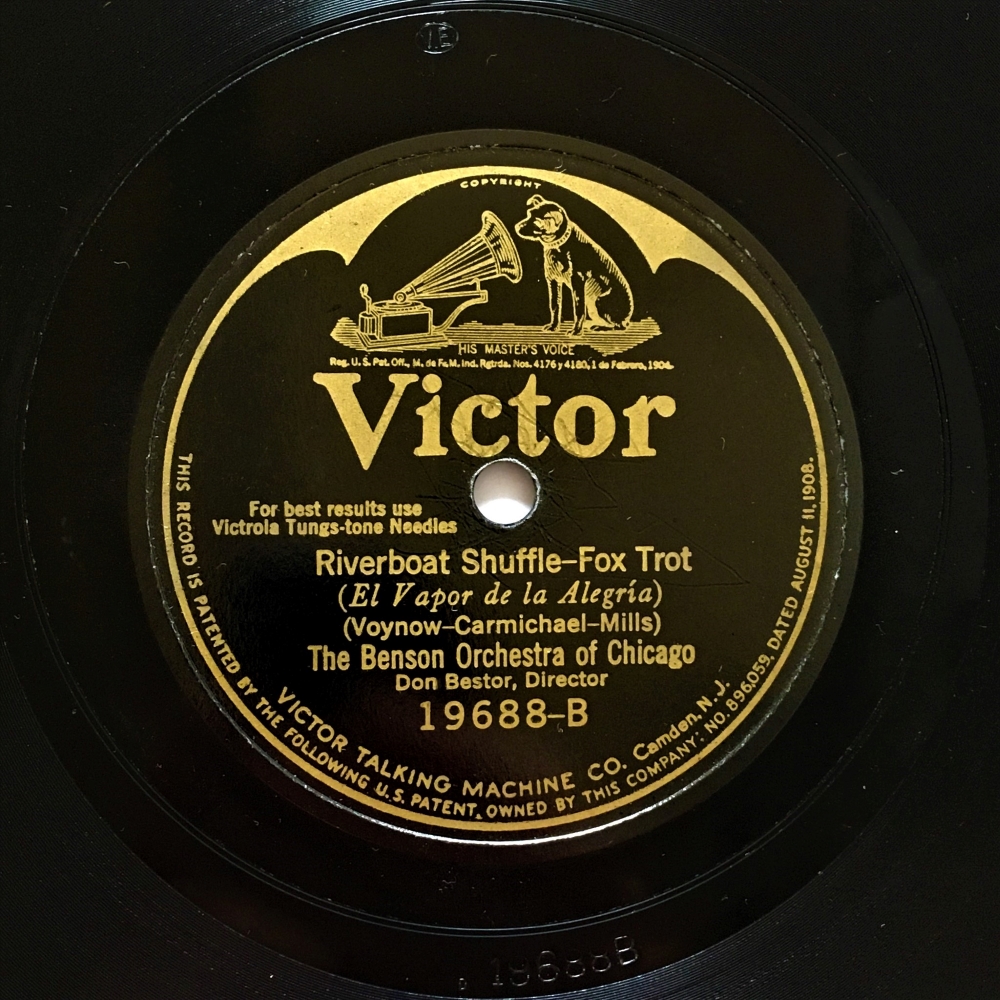前回 は、電気録音黎明期のあれこれについて調べました。今回は、その後発展していく電気録音、そして 1930年前後の各レーベルの状況 について引き続き調べていきます。
On the previous part, I studied on more of the history of Electrical Recording in its very early years, along with several digressions… This time, I am going to continue learning the evolution of the electrical recording, as well as the situation of record labels around the 1930s.
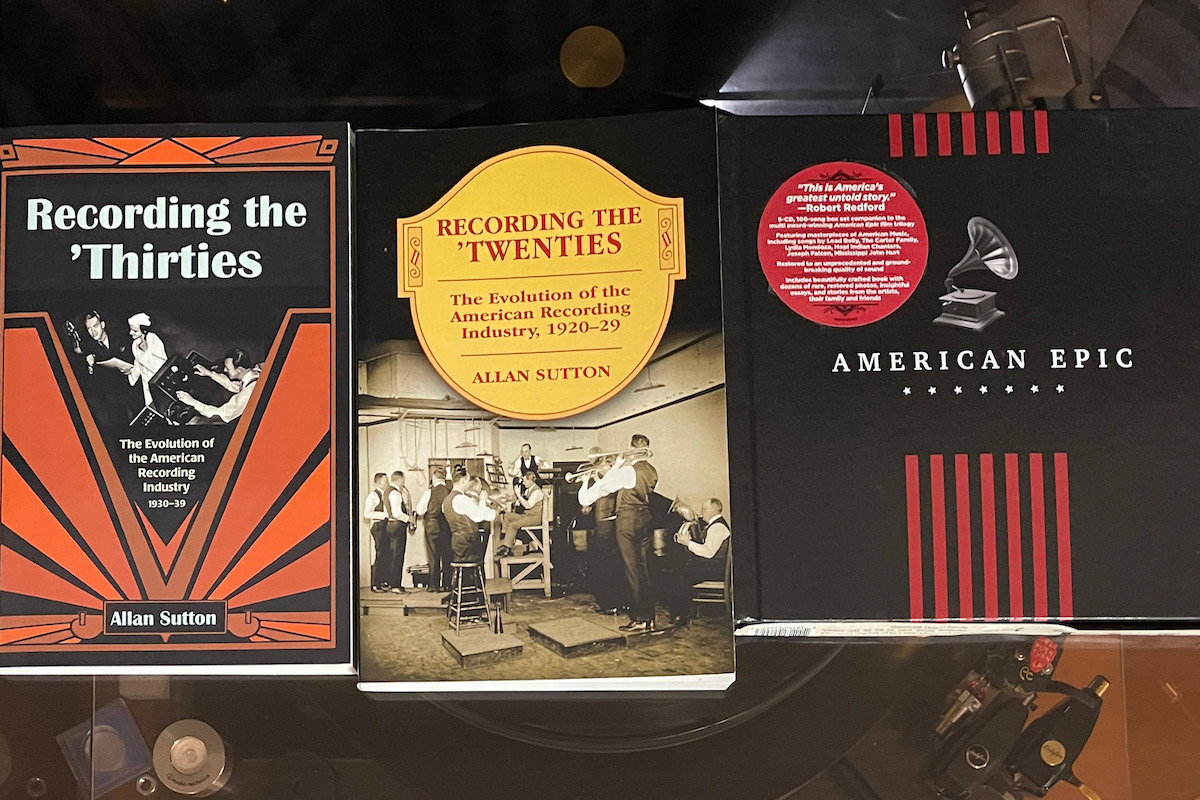
「Pt.0 (はじめに)」、「Pt.1 (定速度と定振幅、電気録音黎明期)」、そして「Pt.2 (世界初の電気録音、Brunswick Light-ray、ラジオ業界の脅威)」の続きです。
This article is a sequel to “Things I learned on Phono EQ curves, Pt.0”, “Pt.1” and “Pt.2”.
前回も書きましたが、筆者自身の学習過程を記したものですので、間違いの指摘や異論は遠慮なくお寄せください。
As I noted in the previous article, this is the footsteps of my own learning process, so please let me know if you find any mistakes on my article(s) / if you have different opinions.
今回も相当長い文章になってしまいましたので、さきに要約を掲載します。同じ内容は最後の まとめ にも掲載しています。
Again, this article become very lengthy – so here is the summary of this article (the same contents are avilable also in the the summary subsection).
Bell Labs / Western Electric のラバーライン録音システムの特許使用料が高かったため、特許を回避した独自録音システムが生まれていった。その中で最も重要な、現代につながる発明は、英Columbia (後の英EMI) の Blumlein が開発した録音システムであった。
Many companies tried to invent electrical recording systems that did not infringe the Western Electric’s patent. The most important development was the system invented by Blumlein of GB Columbia (later GB EMI).
RCA Victor は引き続きラバーライン録音システムを改良し使い続けたが、マイクの開発が進むにつれ、当初のWEマイクにあった中高域が持ち上がった特性に注目し、ディスク録音における中高域のプリエンファシスの重要性が徐々に認識されていった。これがのちに民生用レコードにおける録音カーブの一部となった可能性がある。
RCA Victor continued using and improving the Rubber-line recording system. As the microphone technology improved, treble lift (that originally derived from WE microphones’ characteristics) caught their attention. Later it (highly probably) could lead the germination of the later “treble preemphasis” of the recording EQ curve for consumer disc records.
WEマイクによる中高域特性(のちにRCAリボンマイクのプリアンプによる中高域増幅)を、録音カーブとしての中高域プリエンファシスとみなすと、高域を補正して再生するのが正しいといえる。一方で、マイクやプリアンプによる中高域増幅の音が好まれていた、という意味においては、高域はフラットのまま再生するのも正しいと言える。
WE microphones’ treble boost can be regarded as an intentional treble preemphasis (as a recording EQ curve) – in this sense, it would be correct to play such records with treble compensation. On the other hand, as people prefered WE microphone’s sound with treble boost (later boosted by RCA ribbon microphone’s preamp) at that time, it would also be correct to play such records with “FLAT” (no treble compensation).
民生用(市販用)のレコードと、プロフェッショナル向け(主に放送局用)のレコードは、当時は求められる厳密さ(録音時の特性、再生機器の特性など)が全く異なっていた。次回に触れるが、高域プリエンファシスを意図的に行ったのは、放送局用トランスクリプション盤が先であった。
Commercial disc records (for public) and Professional disc records (for broadcast stations) are very different in terms of required strictness (recording characteristics, frequency response of playback equipments, etc.): Electrical transcription discs for broadcast station was the first example of the application of the intentional treble preemphasis, as I will mention in the next part of the article.
Contents / 目次
- 3.1 “The American Epic Sessions”
- 3.2 WE’s Expensive License Fee / WE録音システムのライセンス料問題
- 3.3 Blumlein System
- 3.4 RCA Victor System
- 3.4.1 RCA’s acquisition of Victor Talking Machine Company / RCA による Victor の買収
- 3.4.2 Improvements on WE Rubber-Line System / WE ラバーラインシステムの性能向上
- 3.4.3 When RCA Victor Switched to Their Own Recording System / RCA製独自録音システムへの変更時期
- 3.4.4 Advent of Ribbon Microphones / リボンマイクの登場
- 3.4.5 Emulating WE microphone’s resonance peak with mic’s preamplifier / マイクのプリアンプでWEマイクのレゾナンスピークをエミュレート
- 3.5 Columbia System…???
- 3.6 New Recording Chain
- 3.7 The summary of what I got this time / 自分なりのまとめ
- 余談
3.1 “The American Epic Sessions”
またまた余談から入ってすみませんが、ちょうど今回の調査や学習をやっている最中、某所でとんでもない映像を目にしてしまいました。
Yet another digresstion before the main topic… one day while I was doing some researches and studies of the history of recording technologies, I came across a staggering video, just unintentionally.
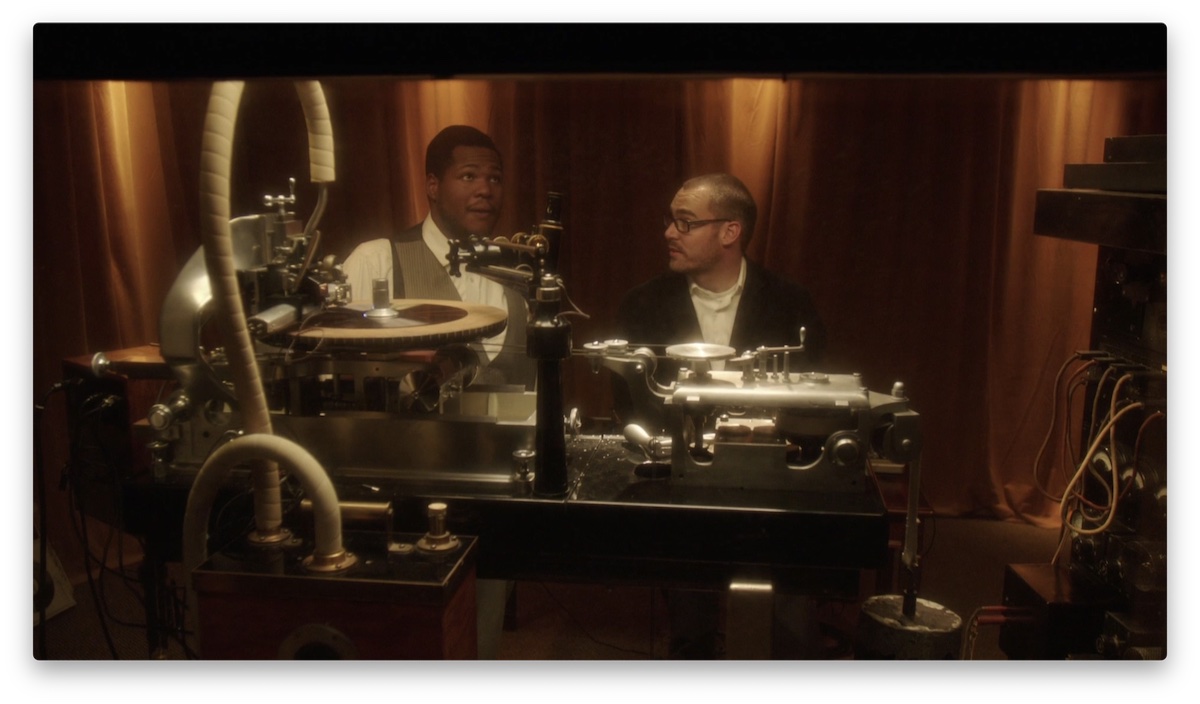
これがドキュメンタリー “The American Epic Sessions” に登場する Bell Labs / Western Electric のラバーライン録音システム。左は Jerron “Blind Boy” Paxton さんで、右がエンジニア Nicholas Bergh さん
Jerron “Blind Boy” Paxton (left), Nicholas Bergh (right), and the Bell Labs / Western Electric “rubber-line” recording system, as appeared in the “The American Epic Sessions” documentary (2017)
日本未公開らしく(追記:実際には2022年9月2日に、Peter Barakan’s Music Film Festival 2022 で日本初公開されていました)全く知らなかったのですが、2017年に PBS / BBC で初公開された、4つのエピソードからなるドキュメンタリーシリーズ “American Epic” です。
It was the award-winning documentary series “American Epic”, premiered on PBS / BBC in 2017 (I just didn’t know but the Japanese premiere of this film was at “Peter Barakan’s Music Film Festival 2022 on Sep. 2, 2022). It has four episodes.
その中の1本、“Episode 4: The American Epic Sessions” では、1929年当時使われていた Bell Labs / Western Electric の録音機材や当時のマイクをフルレストアし、Beck、Bettye Lavette、Elton John、Los Lobos、Jack White、Willie Nelson、Taj Mahal その他錚々たるメンツがダイレクトカッティングで収録しているのです。まさに、この記事 (Pt.1) で紹介した Western Electric ラバーラインレコーダのホンモノが、90年近くの時を経て、現場で使われている のです。
One of the documentary is entitled “Episode 4: The American Epic Sessions” – featuring Beck, Bettye Lavette, Elton John, Los Lobos, Jack White, Willie Nelson, Taj Mahal, and many others – capturing a series of astonishing “direct-to-disc” recording sessions, with super-vintage recording equipment system featuring Bell Labs / Western Electric’s “rubber-line” recorder (that I wrote in the Pt.1 of this article), amplifier, and vintage microphones. They were used for actual recording session nearly 90 years after they were manufacturered.
しかも、当時ラバーラインレコーダを含む録音機材一式は買い切りではなくリースでしたので、現存する個体がほぼ存在しないはずなのに、なぜかこの映画の中に登場するのです。
As a matter of fact, it’s nothing but a miracle, because these entire equipments of 1920s-1940s were leased from Western Electric (not sold outright), and virtually none of them should survived. However, the WE system is here in the documentary as we see.
なんと、録音を担当した Endpoint Audio Labs の Nicholas Bergh さんが、ほとんど資料が残っていないこの機材一式について世界中からパーツと情報を集め、10年がかりでレストアし、さらに改造を加えたというのです。論文の中にイラストや白黒写真でうかがい知ることが出来るのみだった、あのラバーラインレコーダが、完動状態で、そこにあるのです。
Surprisingly enough, it was Mr. Nicholas Bergh of Endpoint Audio Labs, who had collected every bit and piece of the system from all around the world, with enormous effort to identify technical specifications or “how it should work”. He spent many years for getting it fully restored (and modified), getting ready for real recording sessions. There are no words to describe how much I (we) thank for his tremendous efforts – restoring the system that previously we could know with ancient technical papers and documentation, just as illustrations or b/w photos. Again, the working WE rubber-line system is there.
あまりに興奮したので、すぐに海外から Blu-ray を取り寄せ(笑)、隅々まで目をこらして映像を観たのち、Nicholas さんにコンタクトをとってみると、数日後、とても親切に回答をくれました。そして、こちらからのいろんな質問に対して、非常に貴重な多くの意見やコメントをいただきました。本当にありがとうございます。Nicholas さん情報で得た数々の知見は、もちろん当連載にも取り入れていきます。
I was shocked, actually. So I instantly bought the Blu-ray version of the documentary from the US, watched the documentary in every detail, then tried to send an email to Nicholas-san. After a few days, he kindly replied to me, with fruitful information and comments I didn’t even know. I cannot thank you enough Nicholas! With all the information I had from Nicholas-san, I will write the rest of my articles.
このセッションで録音された楽曲はCD化されています。1929年の録音機材を使って21世紀に録音された、現代からするとナローレンジな音源、軽く混乱する感じですが(笑)本当に隅々まで興味深く、素晴らしい演奏と相まって、無限に楽しめます。
Recorded materials are available on CD. All the performances, recorded with narrow frequency range using the vintage 1929 equipments, but recorded in the 21st century – the fact and the sound really makes us a bit perplexed, but anyway the entire recordings are really interesting in every detail – also all the performances are superb – I can say I will enjoy the CD infinitely.
また、録音セッションではない方の、本編ドキュメンタリーについても、当時の音源が非常に優れた(Nicholas さんの研究成果による)トランスファーでCD化されており、こちらも本当におすすめです。
Also, for the main documentary series (not the American Epic Session), 5CD binder set is released – featuring superb transfers of the original 1920s-1930s recordings. Highly recommended.
特に Nicholas さんがおすすめするのは、誰もが知る名曲、ロバート・ジョンソン (Robert Johnson) の Cross Road Blues (1936) とのことです。
Among these excellent transfers, Nicholas-san recommends “Cross Road Blues” (1936) by Robert Johnson, the masterpiece performance everybody should know.
A good recording for you to hear is Robert Johnson’s Crossroad Blues in the American Epic Box. This was recorded on lacquer in the field with flat high frequency (no emphasis). It has a bit of sharpness to the recording and this is due to the peak in the condenser microphone used. It is a very different sound than typical studio recordings of the same time. There is no noise reduction except for tick removal. It was from a vinyl test pressing rather than shellac.
Kohji にぜひ聴いてもらいたいおすすめの好録音は、American Epic Box に収録されている Robert Johnson の Cross Road Blues だね。この録音は、フィールドレコーディングで、高域はプリエンファシスなしにフラットでラッカーに記録されている。録音時に使用されたコンデンサマイクのピーク特性のせいで若干シャープな音になっているけどね。この音は、同時期にスタジオ録音された音の傾向とはかなり異なっている。CDに収録した音源は、スクラッチノイズの除去以外はノイズリダクションはなにもしていない。これは、市販されたシェラック盤ではなく、テストプレスのヴァイナル盤から収録したものだ。
quoted from the email written by Nicholas Bergh to me on Sep. 28, 20223.2 WE’s Expensive License Fee / WE録音システムのライセンス料問題
さて、そろそろ主題に戻ります。Bell Labs / Western Electric の「Rubber-line」電気録音、および、Brunswick / General Electric の「Light-Ray」電気録音、まで書きました。
Well, it’s time to go back to the main theme – so far I have noted the “Rubber-line” electrical recording by Bell Labs / Western Electric, as well as “Light-Ray” recording technique by Brunswick / General Electric.
電気録音時代最初期を席巻したのは Bell Labs / Western Electric 方式で、Victor や Columbia など大手を含め数々のレーベルで採用されましたが、大きな問題がありました。
Bell Labs / Western Electric system dominated the very early electrical recording scene – adopted by major labels Victor and Columbia, as well as some other labels. But there was one big problem.
録音技術自体が Western Electric の特許で守られており、また録音機材一式も買い切りではなく特許料込みの機材リースだったようで、当システムで録音するたび、さらに録音をレコードにプレスして売るたびに、特許使用料が必要だったそうです。で、このリース料(特許使用料)がかなり高かった、と。
Recording equipments and technology were patented by Western Electric: the whole system was not sold outright, but leased. Patent royalty fee must be paid for each recording, as well as each 78rpm sales. And the lease/royalty fee was said to be very expensive.
どのくらい高かったか、以下のサイトから引用します。
The below webpage describes how expensive the license/royalty fee was – here is the excerpt:
The Western Electric system was to be licensed and leased; not sold, and was expensive. It required Victor and Columbia each to make an up-front payment of $50,000 (equivalent to more than $600,000 in current value) followed by payment of a variable royalty per record, but which averaged approximately $0.01 per disc (equivalent to about $0.12 today). The annual minimum royalty was set at $25,000, or about $300,000 in current value. So, this minimum royalty was equal to the entire Victor earnings for the previous year of 1924.
Western Electric システムは売り切りではなく、ライセンスかつリース式であり、そして高価であった。Victor と Columbia に要求された前払金は $50,000 (現在の貨幣価値でいうと $600,000)にもなり、レコードごとに変動性のロイヤリティの支払いが必要で、これは平均すると1枚あたり$0.01(現在で言うと $0.12 に相当)になった。年間の最低ロイヤリティも設定されており、$25,000(現在でいうと $300,000 に相当)であった。この最低ロイヤリティ金額は、Victor が1924年にあげた利益と同額であった。
“Licensing the Western Electrical Recording System”, The Stokowski Legacy3.2.1 The Great Economic Depression / 世界恐慌
ましてや、あの1929年暮れの 世界恐慌 (大恐慌) がありました。
Also it was during the spark of the Great Economic Depression in 1929.
大恐慌によって世界的に不景気になり、レコードの販売枚数は全盛期の1/10以下にまで落ち込んでしまった、そんな時代です。
Global recession deepened, and record sales went less than one-tenth of the peak.
The onset of the Great Depression combined with the ever-growing popularity of radios caused the near-total collapse of the record industry in the early 30s. Never before or since have sales ever dropped so precipitously, falling from over 100 million units in the US in 1929 to just 6 million in 1932. On top of this, the increased competition from independents as well as radio through the 1920s had forced most labels to lower the price of their pop records from $1.00 to 50 cents before the collapse began. It became so hard to turn a profit that by the mid-30s, nearly all the independent labels either disappeared or were bought by the remnants of the majors, with the majors themselves soon bought out by the radio companies (RCA bought Victor, CBS bought Columbia and semi-major Brunswick/Vocalion, and Edison’s National Phonograph Company went bankrupt.)
世界恐慌の勃発の影響、更にはラジオのさらなる普及も加わり、1930年代前半のレコード業界はほぼ壊滅的な打撃を受けた。1929年には全米で1億枚以上あったレコード販売枚数が、1932年にはわずか600万枚にまで落ち込んだ。このような急激な落ち込みは後にも先にも類をみないものである。更には、独立系レーベルやラジオとの競争が激化、その結果ほとんどのレーベルがレコード販売価格を1ドルから50セントに下げざるを得なくなった。そして、1930年代半ばになると、各社とも利益を上げることが困難になっていた。その結果、ほとんどの独立系レーベルは倒産するか、メジャーレーベルに買収された。更には、そのメジャーレーベルですら、ラジオ会社に買収された(RCA は Victor を、CBS は Columbia およびセミメジャーの Brunswick/Vocalion を買収した。そして、エジソンのナショナル・フォノグラフ社は破産した)。
“History of the Record Industry, 1920— 1950s Part Two: Independent labels, Radio, and the Battle of the Speeds”Although Charles Edison, the elder son from his second marriage, became president of Thomas A. Edison, Inc. in 1926, Edison did not finally retire from business until 1927. Thereafter Charles and his brother Theodore, a graduate of the Massachusetts Institute of Technology, managed to make some moves toward the latest radio-phonograph technology. Before they could release anything for a new electlically recorded catalog, the Edison phonograph business was bankrupt. Edison’s entertainment phonograph business was discontinued in 1929.
トーマス・エジソンの再婚相手の長男チャールズ・エジソンが Thomas A. Edison 社の社長に就任するも、トーマスは1927までビジネスから撤退しなかった。その後、チャールズと彼の兄弟であるセオドア(マサチューセッツ工科大学卒業)が、最新のラジオ・蓄音機技術について少しずつ動き出していた。しかし、新しい電気録音のカタログをリリースする前に、エジソンの蓄音機事業は倒産してしまった。そして娯楽用蓄音機事業は1929年に廃止された。
“Thomas Edison and Modern America: An Introduction with Documents”, p.26結果、ライセンス料支払いを回避すべく、各社は Western Electric 社の特許に抵触しない電気録音システムの独自開発 に向かうことになります。とはいえ、開発できるのはごく一部のレーベル企業に限られていた時代、レーベルから独立したカッティングスタジオなどなかった時代であることに変わりはありません。
As a result, in order to avoid royalty payment, many companies tried to invent electrical recording systems that did not infringe the Western Electric’s patents. On the other hand, please note that there was not a “independent” recording/cutting studio these days – only a handful of major labels had such equipments, and could develop their own systems.
3.3 Blumlein System
もっとも有名なのが、1929年に英Columbiaの研究所に加入した天才エンジニア アラン・ダウアー・ブラムレイン (Alan Dower Blumlein) (1903-1942) が発明したシステムで、これが現代に至るレコードカッティング技術の直接の祖先となります。
Most famous one would definitely be the system developed by the engineering genius Alan Dower Blumlein (1903-1942), who joined the research department of the Columbia Gramophone Company (GBR) and invented many technological foundations that became the direct ancestor of modern disc recording technology.
Happy Birthday to legendary engineer and inventor of stereo, Alan Dower Blumlein!
— Abbey Road Studios (@AbbeyRoad) June 29, 2020
This photo, courtesy of @EMIArchiveTrust, is one of the first of Blumlein’s inventions in the 1930s – the moving coil cutting lathe, designed to replace Western Electric Corporation’s older model. pic.twitter.com/Haz0jpZUOC
しかも、特筆すべきことに、Blumlein 氏は1931年の英国特許394,325 “Improvements in and relating to Sound-transmission, Sound-recording and Sound-reproducing Systems” において、現在の 45/45 方式のステレオレコードの録音再生技術を発明しているのです。1957年11月、Audio Fidelity レーベルが 世界初のステレオLP AFLP-1872 を製造販売した時から26年も前のことです。
Furthermore, Blumlein also invented the current standard 45/45 stereo disc recording/reproducing technology, in the GB patent 394,325 “Improvements in and relating to Sound-transmission, Sound-recording and Sound-reproducing Systems”, published way back in 1931 – what a remarkable invention. It was 26 years before Audio Fidelity label produced and sold the world’s first stereophonic LP record (AFLP-1872) in November 1957.
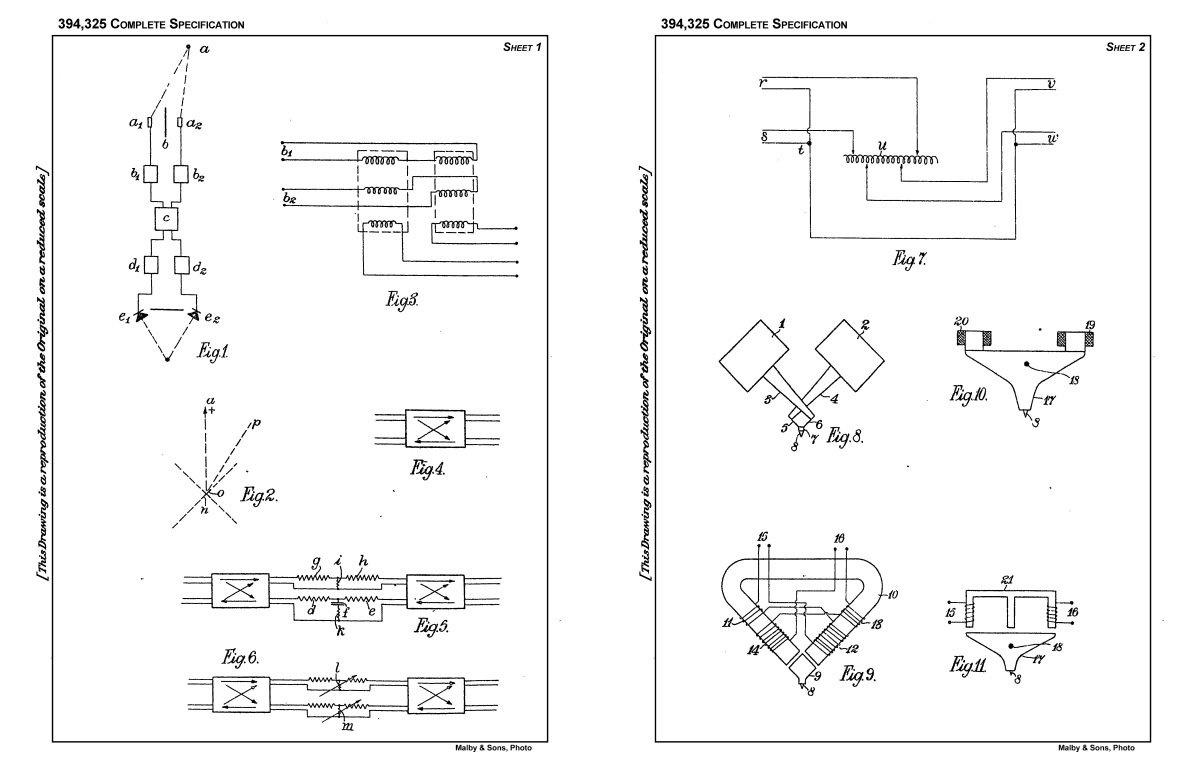
source: “Improvements in and relating to Sound-transmission, Sound-recording and Sound-reproducing Systems”, Alan Dower Blumlein, GB Patent 394,325, 1931
1931年12月14日出願、1933年6月14日受理の、英国特許 394,325 に添付された図版
彼の名前がもっとも良く知られているのは、マイクセットアップ「ブラムレイン・ペア」でしょう。双方向性 (bi-directional, figure-8) マイクを90度に重ね合わせてステレオフォニックな録音を実現するマイクセットアップで、これも彼によって生み出されたテクニックです。
Probably his name would be most famous for the “Blumlein pair” recording technique, an array of two matched bi-directional (figure-8) microphones, positioned 90 degrees each other, that is one of the popular microphone setups for stereophonic recording. This technique also was his invention.
さて、録音システムに話を戻すと、Western Electric システムにおけるラバーラインによる機械的ダンピングの代わりに、Blumlein システムでは 渦電流 (eddy current) によるダンピング、および電気的なイコライズによって特性をコントロールしていました。また、カッターヘッドも MI (Moving Iron) 型ではなく MC (Moving Coil) 型となっていました。
Back again to the Blumlein recording system. Unlike the mechanical dumping of the Western Electric’s “Rubber-line” system, Blumlein system applied eddy-current damping as well as electrical equalization to control the frequency response. Also, Blumlein cutterhead was MC (Moving Coil) type, unlike the Western Electric’s MI (Moving Iron) type.
ただし、記録特性のコントロールは相当大変だったようで、駆動するパワーアンプとカッターヘッドの間に挿入されるパッシブイコライザユニットは、カッターヘッドごとに個別のものが用意されていて、異なるカッターヘッドとイコライザの組で使わないように厳格に管理されていたそうです。 (出典: “Manual of Analogue Sound Restoration Techniques”, Copeland, 2008, pp.127-128)
However, equalizing resonance and frequency charactaristic was so troublesome at that time: “each individual cutterhead had its own equaliser, and there were strict instructions to prevent cutterheads and equalisers being swapped.” (source: “Manual of Analogue Sound Restoration Techniques”, Copeland, 2008, pp.127-128)
当時プレスされたテストレコードの特性からすると、1933年当時は 200Hz あたりがターンオーバー周波数で、2kHz から上はゆるやかに減衰するような特性で 8kHz あたりまで記録、1936年のテストレコードではターンオーバー周波数が 500Hz(時定数318μs)あたりに変わっており、その上の帯域のゆるやかな減衰もなくなり、上限の 8.5kHz までフラットに定速度記録、となっていたそうです。
According to the frequency characteristics of the test discs by the Blumlein system, the 1933 disc (TC17, 5403) suggests the turnover frequency of 200Hz, and gentle roll-off above 2kHz up to 8kHz; the 1936 disc (HMV DB4037) suggests the turnover frequency of 500Hz (318 microseconds), and no gentle roll-off above 2kHz up to 8.5kHz.
このターンオーバー周波数はテストレコードや時期によってバラつきがあるので一概にどの時期がどの値、とは言えないようですが、ともあれ1931年〜1944年の英 Columbia / HMV などの記録特性は、おおよそターンオーバーが 250Hz(時定数636μs)〜300Hz(時定数531μs)〜500Hz(時定数318μs)前後、それより上の帯域はフラット、ということになるようです。 (出典: “Manual of Analogue Sound Restoration Techniques”, Copeland, 2008, p.129)
Anyway, almos all UK Columbia / HMV / other GB discs during 1931 and 1944 had the recording characteristics of turnover around 250Hz (636 microseconds)〜300Hz (531 microseconds)〜500Hz (318 microseconds) and FLAT roll-off. (source: “Manual of Analogue Sound Restoration Techniques”, Copeland, 2008, p.129)
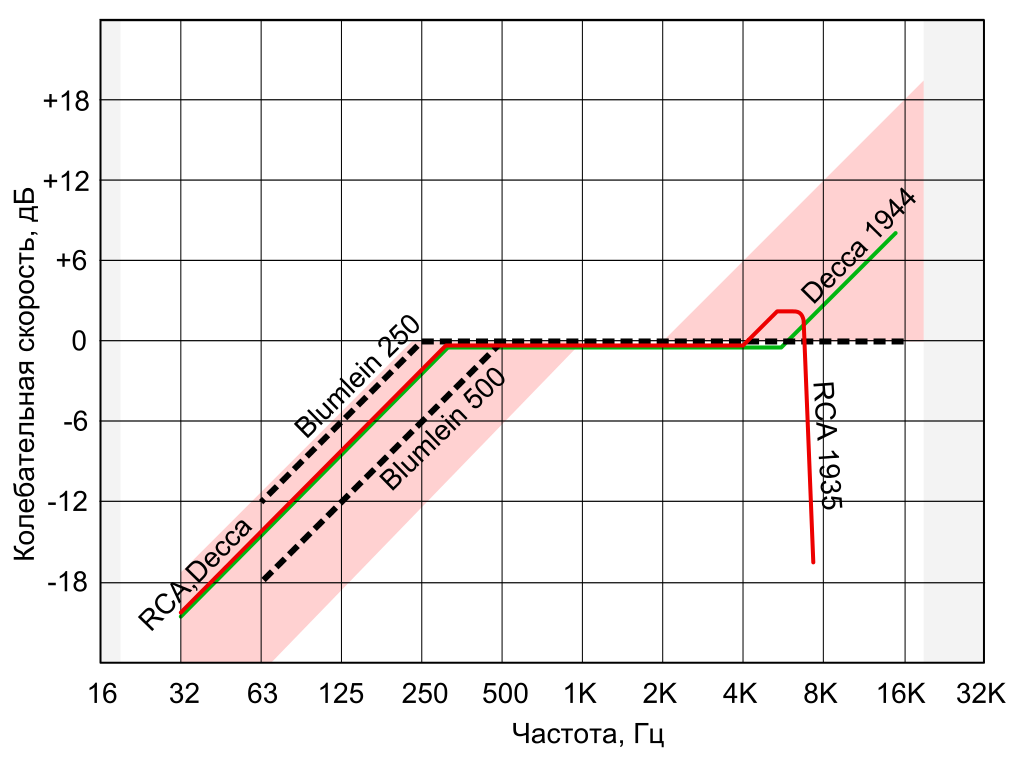
source: Coarsegroove EQ curves.svg (Wikimedia Commons), Public Domain.
1930年代のおおよそのカーブ。
黒い点線が Blumlein 250 と Blumlein 500 で欧州の主流。
ピンク色の領域が米国でのカーブの主流。
Blumlein’s monophonic recording and reproduction system was com- prehensive. Everything from the microphone onwards was designed and constructed in-house, including the microphone amplifiers, level controls, intermediate amplifiers and equalisers to the power amplifiers that drove the recorder and, of course, the recorder itself. Blumlein’s insistence on the need for good correlation between theory and practice demanded the ready availability in the R&D laboratories of appropriate apparatus for determining gains, frequency responses and the amplitudes of the harmonic distortion components. Where suitable equipment could not be obtained commercially, it was designed and built in the laboratories.
ブラムレイン氏のモノフォニック録音再生システムは、広範にわたる総合的なものであった。マイクに始まり、マイクのプリアンプ、レベルコントロール、中間のアンプやイコライザ、録音カッターを駆動するパワーアンプ、もちろん録音カッターのシステムに至るまで、開発・設計・製作は自社内で行われた。ブラムレイン氏は、理論と実践の両方、そして互いの相関を重要視していたので、ゲイン、周波数特性、高周波歪成分の振幅などを測定する適切な装置が、研究開発室にすぐに使える状態で用意されている必要があった。市販の測定装置が手に入らない場合は、研究所内で開発・設計・製作された。
The Life and Times of A.D. Blumlein, Russell Burns, IET History of Technology Series 24, 2000今回の連載は、主に米国での事情ですので、英国や欧州の事情についてはこれ以上深入りしません。
The series of my articles are aimed for the recording systems and EQ curves mainly in the United States, so I will not dig deeper into those in the UK and Europe.
3.4 RCA Victor System
そして、歴史の荒波を乗り越えた RCA Victor です。
Then, the system of RCA Victor, that overcame and survived difficult time of history.
3.4.1 RCA’s acquisition of Victor Talking Machine Company / RCA による Victor の買収
ご存知の通り、RCA は Radio Corporation of America の省略形であり、1919年に General Electric (GE)、Westinghouse、American Telephone and Telegram (AT&T)、United Fruit のジョイントベンチャーとして設立されました。
As you may know, RCA is the abbreviation for Radio Corporation of America. It was founded in 1919, as a patent trust owned by Gneeral Electric (GE), Westinghouse, American Telephone and Telegram (AT&T), United Fruit Company.
その RCA が、ラジオによってレコードや蓄音機の売り上げが落ちていた 1901年創立の老舗 Victor Talking Machine 社 を大恐慌直前の1929年3月15日に配下におき、同年暮れには RCA Victor 社になります。
Then on March 15, 1929 (just before the Great Depression), RCA purchased the Victor Talking Machine Company, that had been struggling with low sales of Phonograph players and disc records (mainly because of the advent of Radio). Then later that year, the company bcame RCA Victor company.
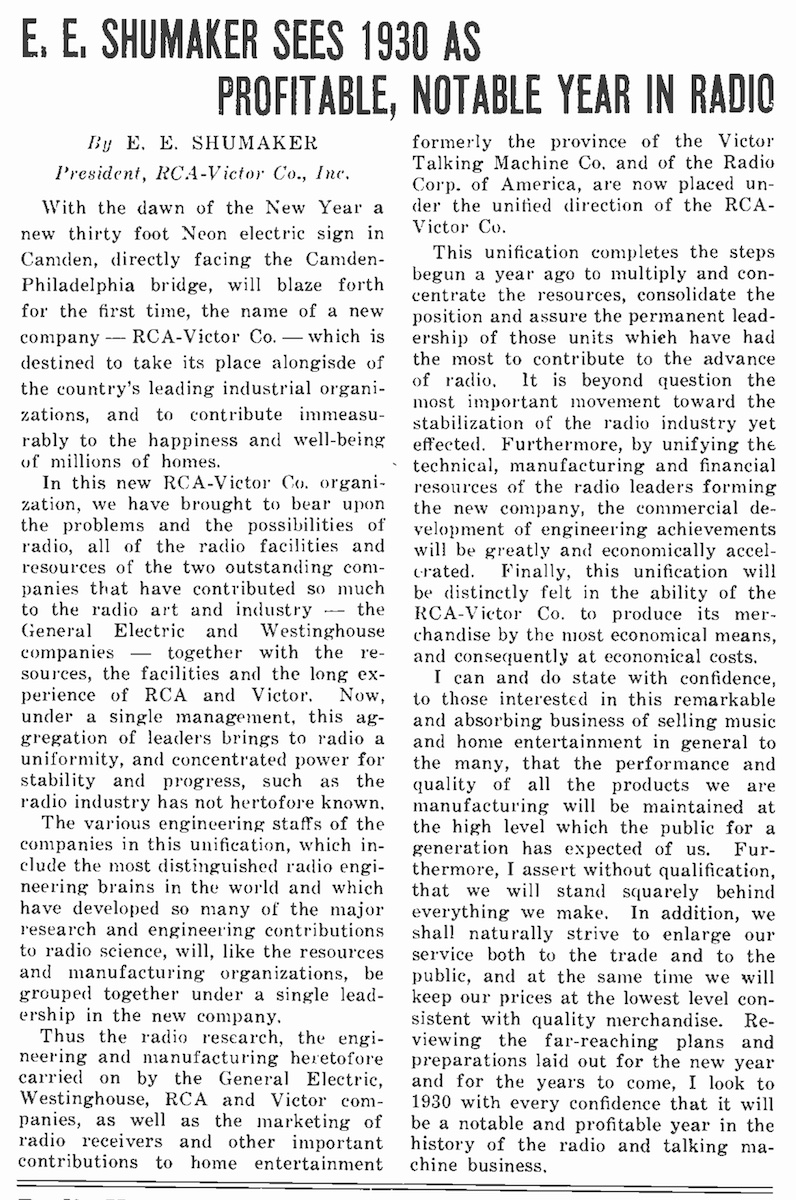
source: “E.E. Shumaker Sees 1930 as Profitable, Notable Year in Radio”, The Talking Machine and Radio Weekly”, p.14, January 1, 1930.
The Talking Machine and Radio Weekly 1930年1月1日号に掲載された、RCA Victor 社長 E.E. Shumaker による記事
RCA / General Electric は、当時 Western Electric とトーキー(サウンドモーションピクチャー、または、サウンドフィルム、音が同期した映像)技術でライバル関係にありました。Western Electric 社は、AT&T社の完全子会社であり、また Bell Laboratories は Western Electric 社と AT&T社が50%ずつ出資して両者の技術・研究部門を引き継いだ会社でした。
RCA / General Electric was a rival Western Electric in the Sound Motion Pictures (or Sound Films) development. Western Electric was a wholly owned subsidiary of AT&T; Bell Labs was a centerization of the engineering departments of AT&T and Western Electric.
サウンドフィルム業界における両グループのライバル関係については “The Talkies: American Cinema’s Transition to Sound, 1926-1931” (Crafton, 1999) などに詳しいです。当該章 “Battle Of The Giants: ERPI And RCA Consolidate Sound” は Encycropedia でも読めるようです。
The Rivaly between these two groups in the sound films industry is described in very detail on “The Talkies: American Cinema’s Transition to Sound, 1926-1931” (Crafton, 1999) for example. The chapter “Battle Of The Giants: ERPI And RCA Consolidate Sound” can be read at Encycropedia somehow.
つまり Victor が RCA に買収されたことで、ライバルである Bell Labs / Western Electric のディスク録音システムを使っていることになります。とはいえ、両者にAT&Tが絡んでいるのがややこしいです。
RCA’s purchase of Victor meant that the Victor was using the disc recording patents of rival company (Bell Labs / Western Electric), although AT&T relates to both groups – it sounds confusing.
ともあれ、RCA Victor は、Bell Labs / Western Electric ディスク録音システムを使い続け、そのシステムの独自改良も行い、かつ自社の独自開発も行い続けていくことになります。特許の権利関係がどうもわかりづらいというか、調べてもよく分かりませんでした。
Anyway RCA Victor continued utilizing Bell Labs / Western Electric disc recording system; and they started their own improvements to the system, as well as their own development of the recording system(s). The relationship of patent rights seems very confusing, and after several searches I gave up…
一方、時は大恐慌時代、ますますレコードや蓄音機の売り上げは伸び悩み、グループの主たる収益や開発投資はラジオ(放送ネットワークや放送用機材)、サウンドフィルム、さらに来るべきテレビジョンの研究開発となっていました。
On the other hand, it was during the Great Depression era – sales of disc records and phonograph players didn’t go well. The primary income for the RCA Victor group was from Radio (broadcast network, equipments for broadcast stations, etc.) and Sound Motion Pictures; their development investment was for the coming Television system.
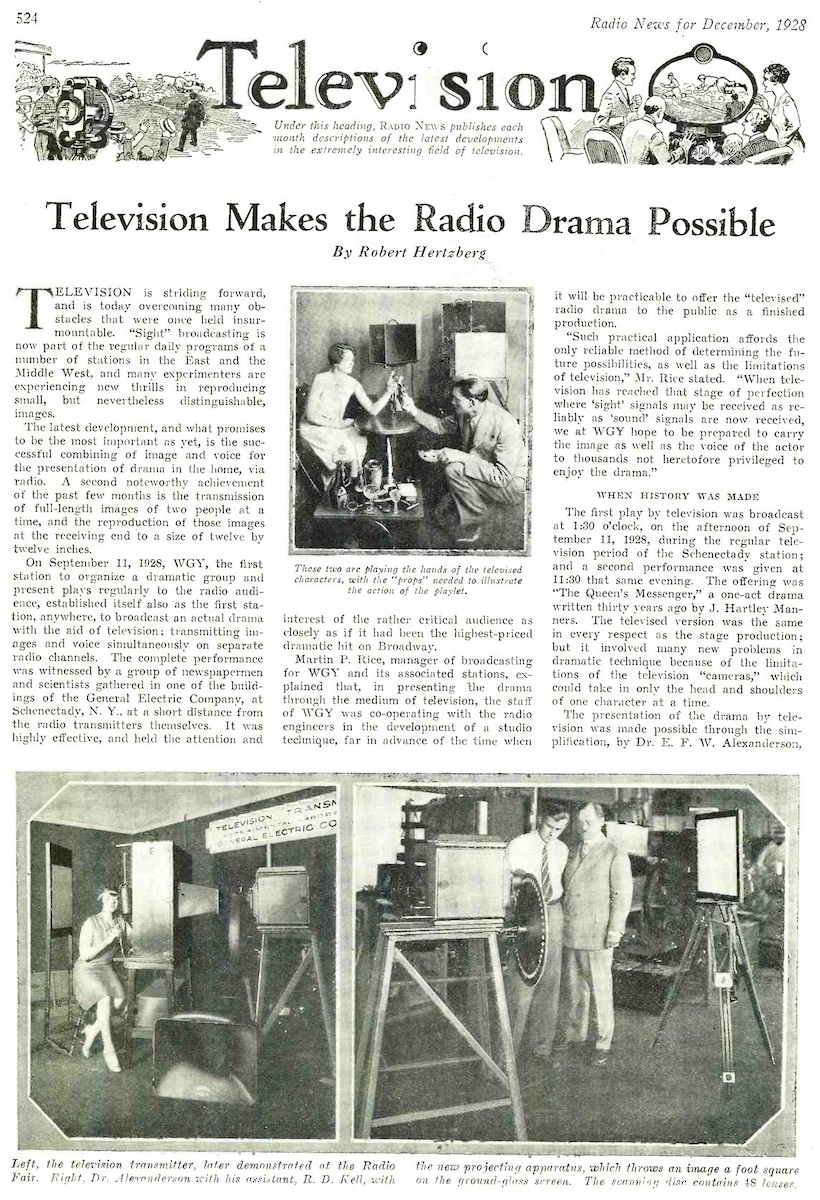
source: “Television Makes the Radio Drama Possible”, Robert Hertzberg, pp.524-528, , Radio News, December 1928
1928年9月11日、General Electric社のX2XAD局により “Queen’s Messenger” が初のドラマ実験映像中継されたことを伝える、Radio News誌1928年12月号の記事
事実、この時期(1930年代)の RCA Victor のあらゆる技術文書を探してみても、ラジオ通信技術やテレビジョン技術のものが大半で、レコード録音システムに関するものが非常に少ないことからも分かります。つまり、レコード録音システムに関する当時の技術詳細があまり残っていないのです。これらの技術は企業内に閉じていて、わざわざ公開する類のものではない、という認識だったこともあるでしょう。
As a matter of fact, I have read many technical documents published by RCA Victor during this period (early-middle 1930s), but I found most of these articles were dealing with such topics as radio telecommunication, broadcasting technique, foundation of tele-vision technology, etc. There are few detailed technical documents on disc recording systems and techniques during these days. Also, such technology was proprietary, and probably not regarded as getting open public.
この時期にはディスク録音に関する技術文書は1つも掲載されていません
no papers on disc recording technology is here
第二次大戦による休刊直前に、トランスクリプション盤の録音についての記事がやっと掲載されています
Just before being suspended in this WWII period, there’s one article found on good transcription disc recording
とはいえ、数少ない技術資料、そして後年の研究などにより、明らかになっていることもあります。
On the other hand, some of the few technical documentations, along with many researches conducted in the past, some evidence and interesting facts are made clear.
3.4.2 Improvements on WE Rubber-Line System / WE ラバーラインシステムの性能向上
RCA Victor が、Bell Labs / Western Electric のラバーラインレコーダをいつまで使っていたのか、については、諸説あるというか、決定的な資料が残っていないようですが、少なくとも1931年や1932年時点では、RCA独自改良版WEラバーラインレコーダをまだ使っていたようです。これは、ターンオーバー周波数より上で記録可能な帯域を8,000Hz程度にまで拡大したもので、それより上は以前同様に定加速度で急速減衰した特性になっています。
Opinion is divided on “until when RCA Victor continued using Bell Labs / Western Electric rubber-line recording system?”. Also, it seems that no definitive documentation was found to determine when RCA switched to another system developed on their own. But many articles and researches suggest that, they were still using the Bell Labs / Western Electric rubber-line system at least in 1931 or 1932, and they even made some improvements to the WE system. This allowed the extended flat frequency range from the bass turnover frequency up to about 8,000Hz, then constant acceleration (rapid decay) above the frequency.
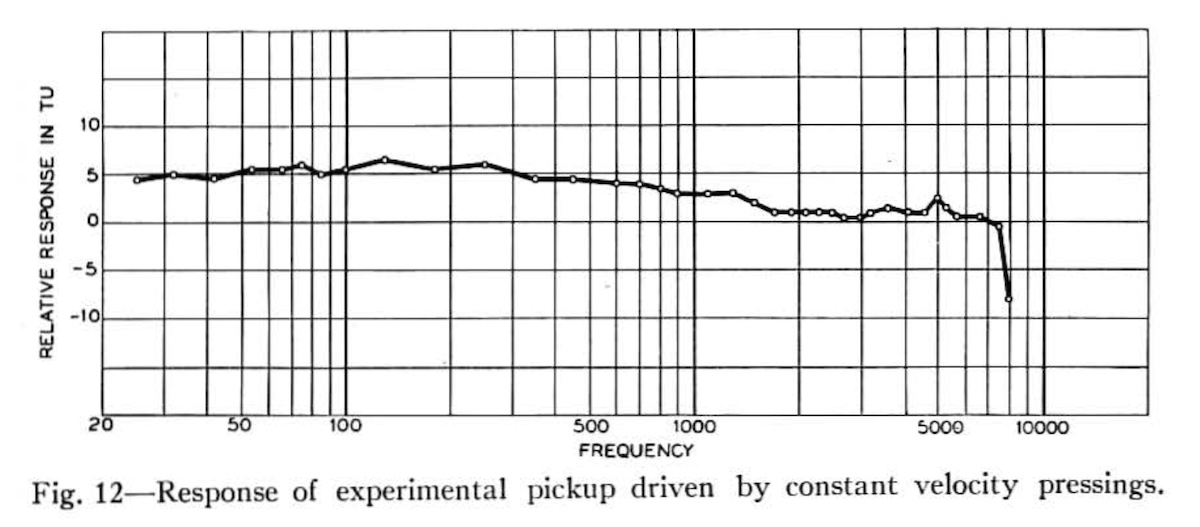
source: “Recent Advances in Wax Recording”, Halsey A. Frederick, Bell System Technical Journal, 8: 1. January 1929 pp 159-172.
archived at Internet Archive (archive.org)
1929年にベル研のFrederick氏が発表した論文の図版。この当時ですでに8,000Hzまでのほぼフラット再生が達成できている
ただし、全帯域定速度記録のテストディスクの再生であることに注意
また、低域ターンオーバー周波数が、以前の250Hz(時定数636μs)あたりではなく、500Hz(時定数318μs)あたりに移動しているのもみてとれます。この 500Hz ターンオーバーに切り替わった時期については諸説あり、Copeland 氏は1931年〜1932年としていますが、具体的な技術資料が残ってないのでなんともいえません。この辺りは1枚ずつ、マトリクス番号ずつ、聴感テストでEQカーブを追い込んでいくしかないでしょうかね。
Another find is that the bass turnover frequency moved up to 500Hz (318 microseconds) or around, not the original 250Hz (636 microseconds) or around. Again, opinion is divided on “when RCA Victor changed the bass turnover frequency to 500Hz”, although Mr. Copeland suggests it occured in 1931, 1932 or around. And again, few technical documentation survived. So we may have to check every record, every matrix number, every subjective listening, with every possible hypothesis.
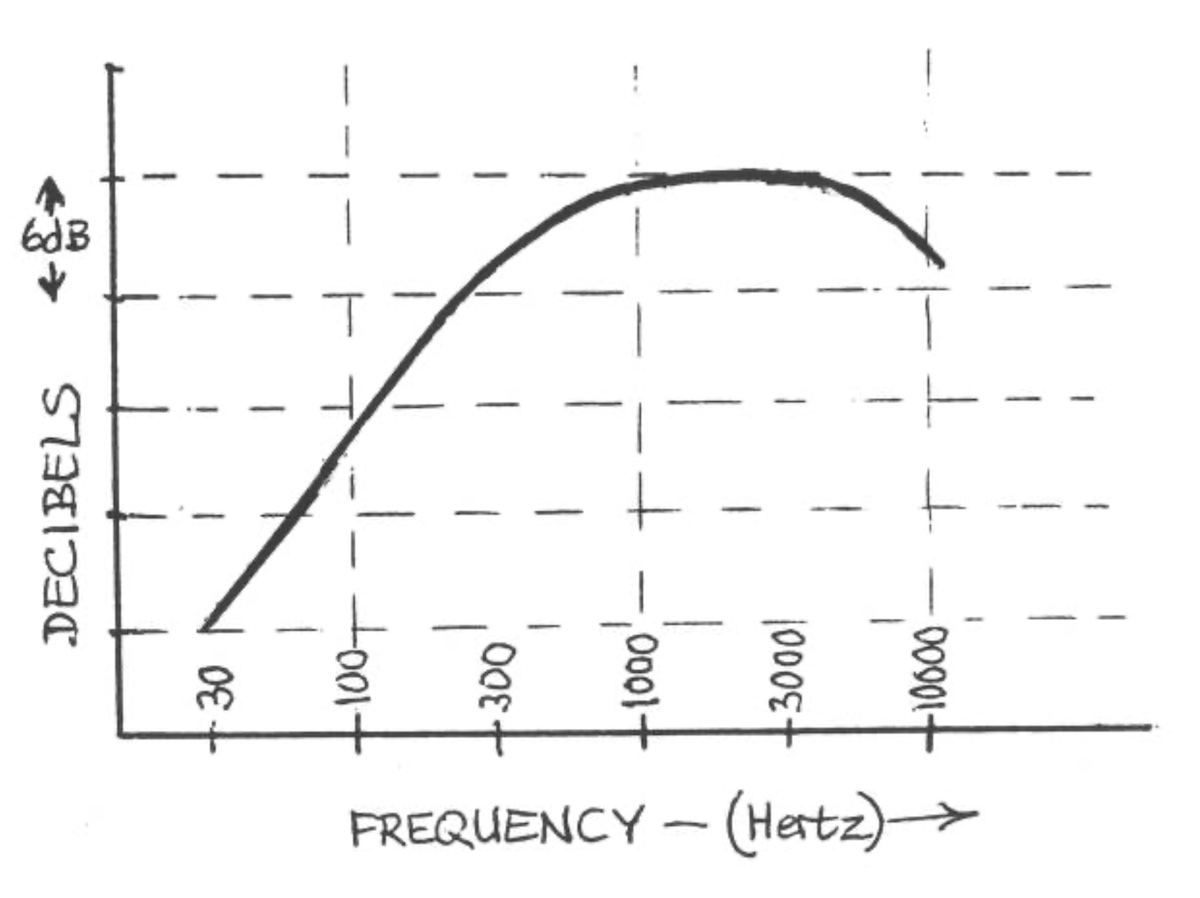
source: “Manual of Analogue Sound Restoration Techniques” p.122, by Peter Copeland, The British Library, 2008.
1931〜1932年頃の製造と思われるテストレコード Victor 84522 の周波数特性
Frequency response of sweep frequency record Victor 84522, made probably in 1931 or 1932.
3.4.3 When RCA Victor Switched to Their Own Recording System / RCA製独自録音システムへの変更時期
WEラバーラインシステムについては、前回触れた論文を含め、多くの資料が残っているのに、1930年代のどこかで使われ始めたはずのRCA製独自録音システムについては、ほぼ何もない状態です。
There are many documents and papers on the Western Electric’s “rubber-line” recording system, like we saw in my previous article. On the other hand, we can hardly find any info on RCA’s own recording system, that RCA started to used sometime in the 1930s.
RCA Victor がいつ頃から自社製録音システムを使い始めたのか、についても、「1931年」「1934年」「1938年」「最後までWE録音システムのRCA独自改良だった」など、諸説入り乱れており、現場の技術資料やメモなどが残っていない(または公にされていない)ことが伺えます。1930年代のどこかのタイミングで自社製録音システムを実運用しはじめ、しばらくはWE製録音システムと並行していた時期があるのかもしれません。
Also, we see various opinions about when RCA Victor started to use their own recording system: “since 1931”, “since 1934”, “since 1938”, or “they kept using RCA modified WE system even in the 1940s” etc. This may suggest there is no clear proof of RCA’s proprietary recording system, like technical documents and memos – or not disclosed public. It also could be that RCA used both WE and RCA systems until sometime in the 1930s.
WE 録音システムと RCA 録音システムについて、非常に興味深い情報があります。
以前書いたブログ記事「Feb. 3, 1932: The First Stereo Sound Recording Known To Exist」で、偶然とらえられたステレオ(的)録音は「WE社製の録音システムとRCA自社製の録音システムの比較検討用に同一演奏を同時に記録された」説を紹介しましたが、その中にこんなことが書かれていました。
一方はWE製録音システム、もう一方はRCA録音システムであった。この同時録音で、自社RCAの録音システムがライバルのWE製録音システムに十分対抗できる品質かをテストした。その結果、RCA は WE製録音システムを1934年まで使い続けた。WE製録音システムの盤には V.E. が楕円で囲まれた刻印がある。1934年に RCA が自社製録音システムの使用を開始した際、刻印は V.E. が菱形で囲まれたものに変わった。
“A new theory about the 1932 Stereo recordings”, originally by Michael Shoshani, p.11, DEMS Bulletin, 1999/1 (March-May)この「WE製録音システムはデッドワックスに楕円V.E.刻印」「RCA製録音システムはデッドワックスに菱形V.E.刻印」の一次情報(当時のエンジニアなどの言質、資料など)を残念ながら見つけらずにいるのですが、もしこれが本当だとすると、当時の RCA Victor および某系レーベルを調べ尽くせば「WE製録音システムがいつまで使われていたのか」「RCA製録音システムがいつから使われ出したのか」が分かることになります。全米で使われていたスタジオによっても移行の差はありそうです。
以下に掲載する写真は、SPコレクターの大先輩、瀬谷徹さん提供のものです。瀬谷さん、ご協力いただき本当にありがとうございます。
Here’s one information, being very very interesting.
A dozen of years ago I wrote a blog article entitled “Feb. 3, 1932: The First Stereo Sound Recording Known To Exist”. In that article, I introduced a new theory (originally by Michael Shoshani on the duke-lym mailing list, then on the DEMS Bulletin, 1999/1, March-May), that the 1932 Ellington “accidental” stereo recording was captured with the WE system AND the RCA system at the same time. It reads something like this:
The two-microphone set-up at the 1932 Ellington “stereo” session consisted of two separate microphones, two separate sets of wires, two separate disc lathes, and two separate wax masters. One was the standard WE system, the other an experimental RCA system. The idea was to see if the RCA system as it then stood could rival the quality of Western Electric’s. It didn’t and RCA did not replace WE’s equipment until 1934. Recordings made on WE equipment have the letters VE in an ellipse; in 1934, when RCA started using its own equipment they put the VE in a diamond.
“A new theory about the 1932 Stereo recordings”, originally by Michael Shoshani, p.11, DEMS Bulletin, 1999/1 (March-May)Unfortunately, I couldn’t find the primary resource (like interviews with the engineers at the RCA recording facilities, technical documents, etc.) of the proof for “for WE system, V.E. in an ellipse stamp on the dead-wax” and “for RCA system, V.E. in a diamond stamp on the dead-wax”. Anyway, if it was correct and true, we would be able to identify “until when RCA used the WE recording system” and “when RCA started using their own recording system”, by searching “every nook and cranny” of all the RCA Victor rpms ever existed during these years. Also, as RCA Victor had multiple recording studios, the transition period would be different among the studios.
Below photos are kindly provided by Mr. Tohru Seya, a huge 78rpm collecor. I sincerely appreciate your courtesy, Seya-san!
recorded in Camden, N.J. on May 23, 1925.
(photo courtesy of Tohru Seya)
recorded in NYC on January 22, 1934.
(photo courtesy of Tohru Seya)
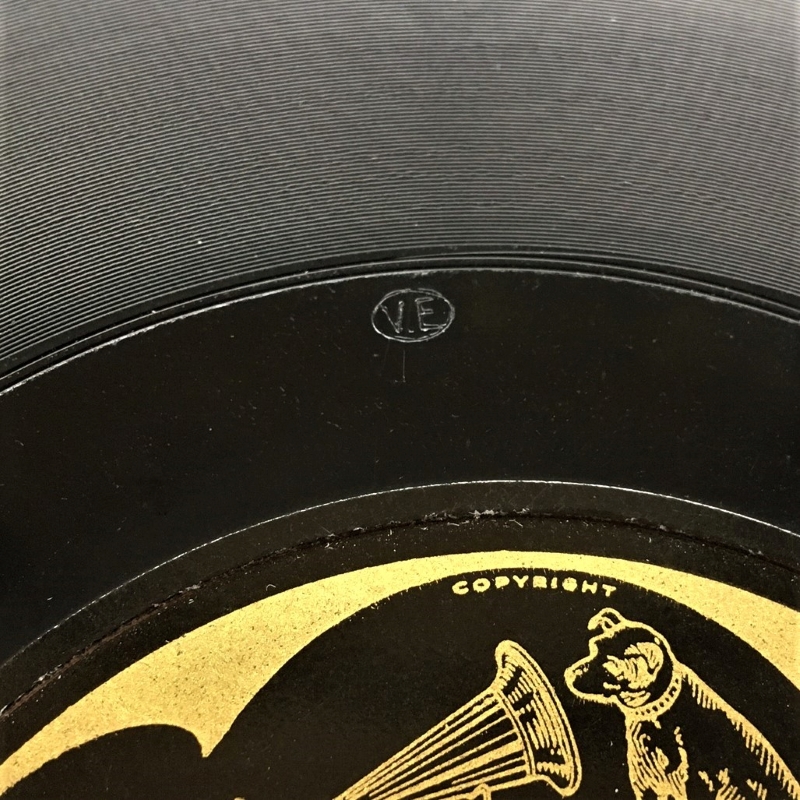
V.E. in a ellipse
Victor 19688-B (1925)
(photo courtesy of Tohru Seya)
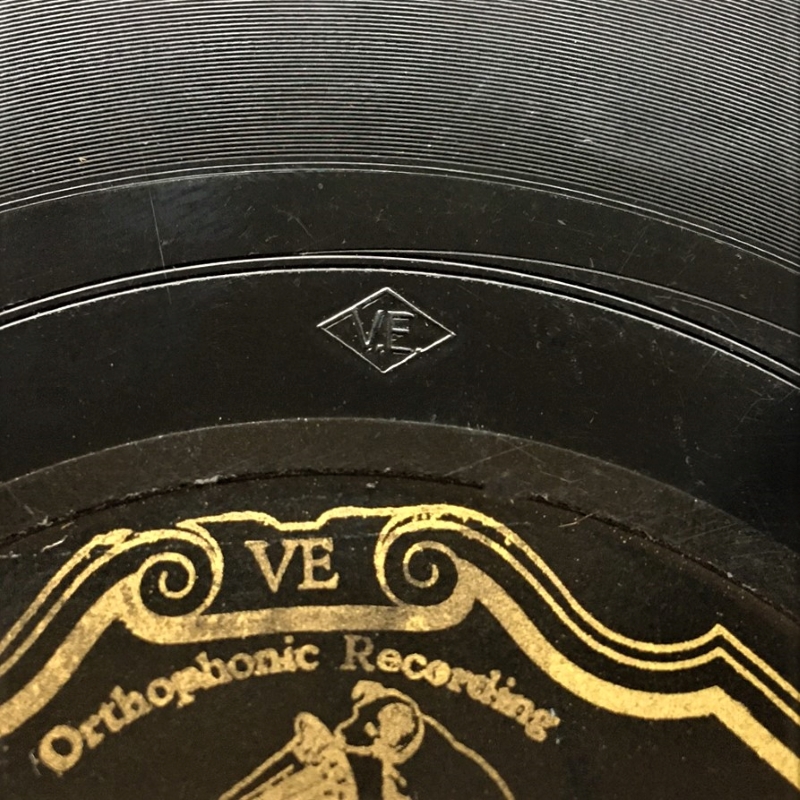
V.E. in a diamond
RCA Victor 24690-A (1934)
(photo courtesy of Tohru Seya)
2022年10月16日追記:
「RCA製録音システム」というのは、Nicholas Bergh さんの ARSC Conference 2022 のプレゼン(ARSC会員のみ閲覧可能)によると、Bell Labs / Western Electric ラバーラインレコーダの精巧なコピー品(笑)を元にして独自改良したもの、とということのようです。RCA Victor 以外のレーベルも、当時入手可能な現物写真や論文をもとに、コピー品のラバーラインレコーダを使っていた、という話も聞かれました。
Update on October 16, 2022:
“RCA system” was, according to the Nicholas Bergh’s presentation at the ARSC Conference 2022 (video available only for the ARSC members), a high quality clone / copy of the original Bell Labs / Western Electric rubber-line recorder. RCA Victor then made their own improvements for the copy. Also, other labels and facilities than RCA Victor also tried to manufacture their own clone version of rubber-line recorder, by inspecting the photos, reading the documentations and papers.

source: Online Presentation by Nicholas Bergh at the ARSC Conference 2022 (available only for ARSC members)
RCA製ラバーラインレコーダ、Nicholas Bergh さんによる ARSC Conference 2022 プレゼンスライドより
(プレゼンはARSC会員のみ閲覧可能)
3.4.4 Advent of Ribbon Microphones / リボンマイクの登場
この時期で興味深いエピソードは、録音機(ラバーラインレコーダ)の特性ではなく、録音時に使われていたマイクの特性です。
The interesting episode from this era is not the frequency response of the “rubber-line recorder” itself, but the frequency response of the microphones that were used in the recording sessions.
Victor や Columbia の最初期電気録音では、Western Electric 361 コンデンサマイクが、1926年暮れから1927年初め頃からは、Western Electric 394 コンデンサマイクが使われていました。これらには、2.9kHz や 3.5kHz といった中高域にレゾナンスピークがあったそうです。
In the early electrical recording days at Victor and Columbia, Western Electric 361 condenser microphone was used; since late 1926 or early 1927, Western Electric 394 condenser microphone was used. Both of them had resonance peak at treble zone, like 2.9kHz or 3.5kHz.
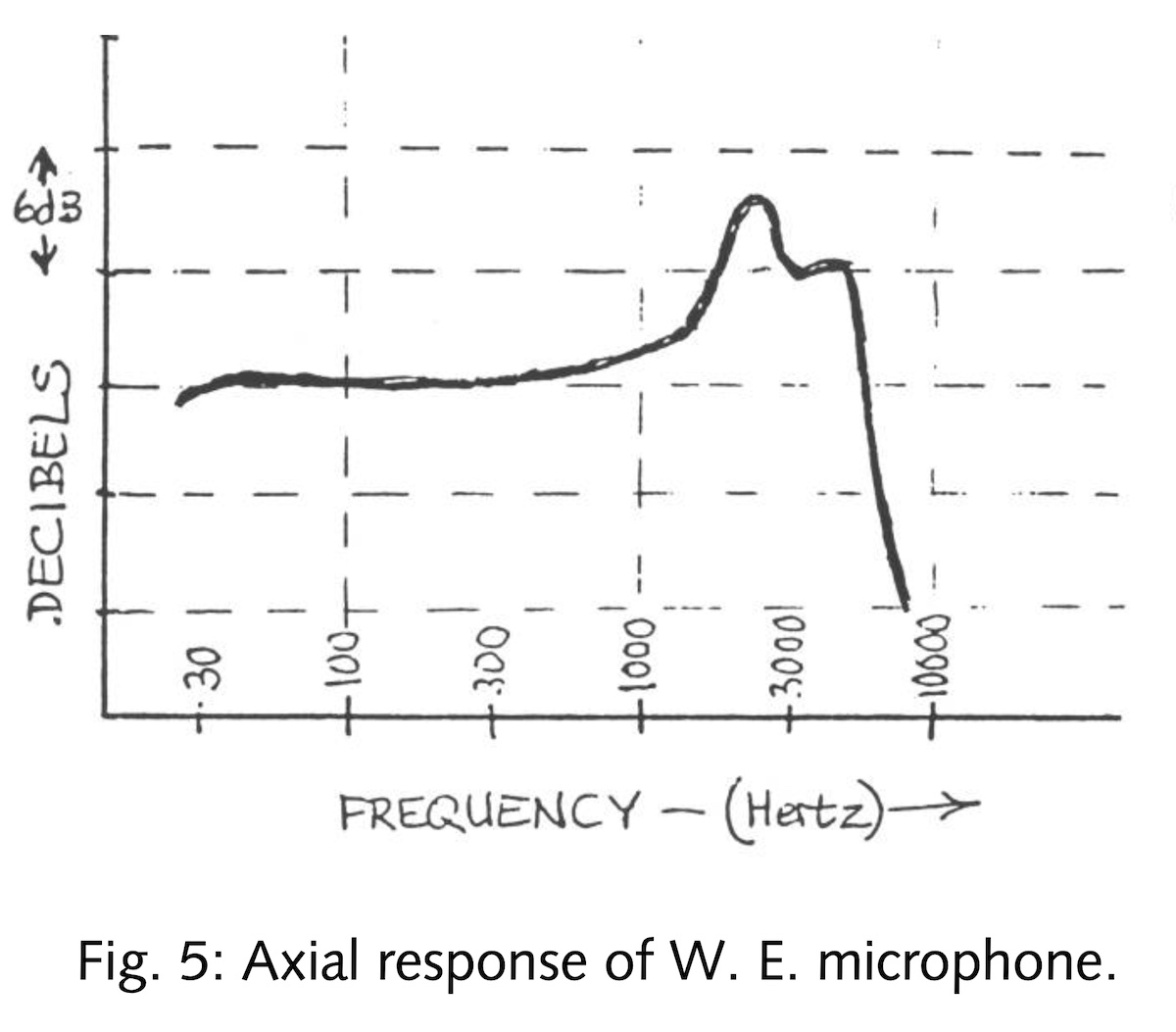
source: “Manual of Analogue Sound Restoration Techniques” p.117, by Peter Copeland, The British Library, 2008.
Western Electric 361 コンデンサマイクの周波数特性グラフ。2.9kHz に +7dB のレゾナンスピークが発生している
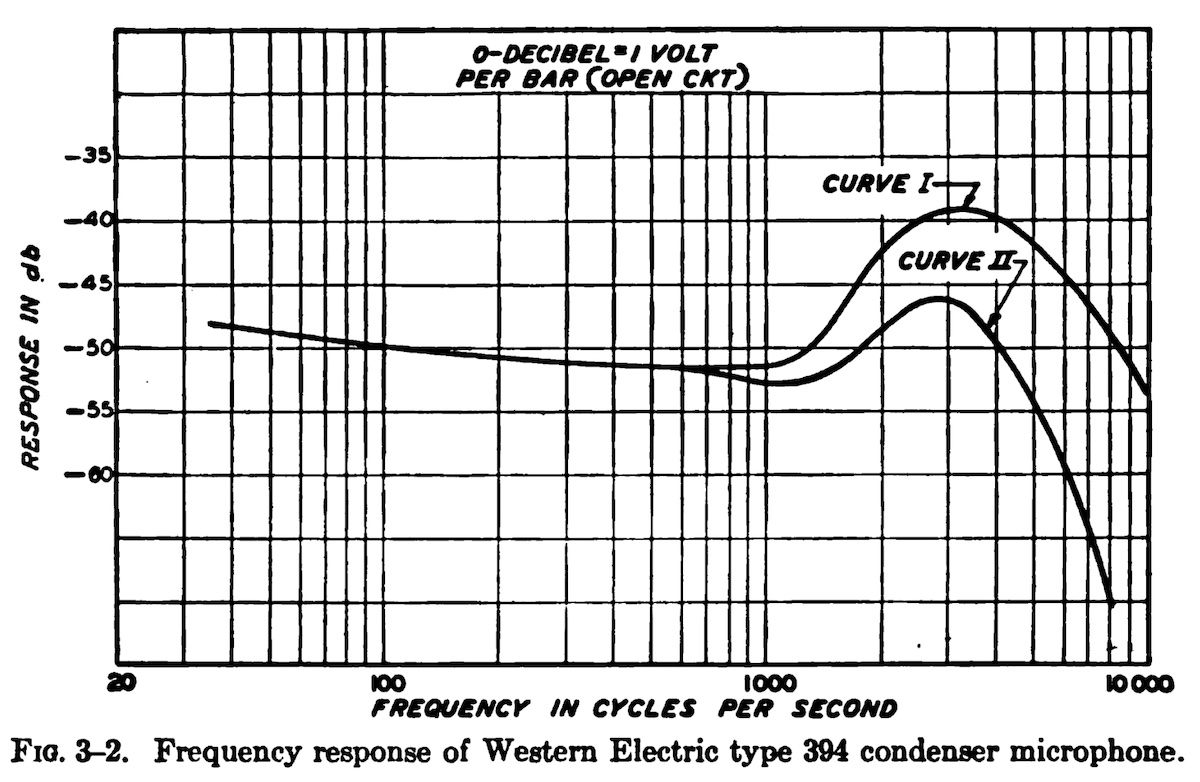
source: “Elements of Sound Recordings”, p. 36, by John G. Frayne and Halley Wolfe, 1949.
Western Electric 394 コンデンサマイクの周波数特性グラフ。3.5kHz に +10dB 以上のピークがみられる
下に載せる引用は、電気録音初期に Bell Labs に勤務していた John G. Frayne 博士へのインタビューからで、AES Journal に掲載されたものです。
The below quote is from the 1990 AES Journal, the interview with Dr. John G. Frayne, who worked at the Bell Labs in the “early electrical recording” years.
The dynamic microphone came out in 1931. Before that, it was all condenser for professional use at the time. The condenser had a peak about 5 or 6 dB at 3.5 kHz.
1931年にダイナミック型マイクが登場した。それ以前は、当時のプロ仕様のマイクは全てコンデンサマイクだった。コンデンサマイクには 3.5kHz に +5〜6dB のピークがあった。
“An Afternoon with John G. Frayne”, Journal of Audio Engineering Society, pp.597-599, Vol. 38, No. 7/8, 1990 July/Augustどうやら、このコンデンサマイクの中高域でのピーク(そして、後述するリボンマイクのプリアンプの特性)が、当時のディスク録音にそのまま反映され、本来なら定速度にフラットになっているはずの中高域が、じゃっかん盛り上がって明るい音となって記録されていた、ということなのです。
So, it seems likely to be that the resonance peak at treble zone – by the frequency characteristics of WE condenser microphones (and by that of preamplifiers for ribbon microphones, that will de described later) – was fed to the cutting amplifier, resulting in bright treble sound.
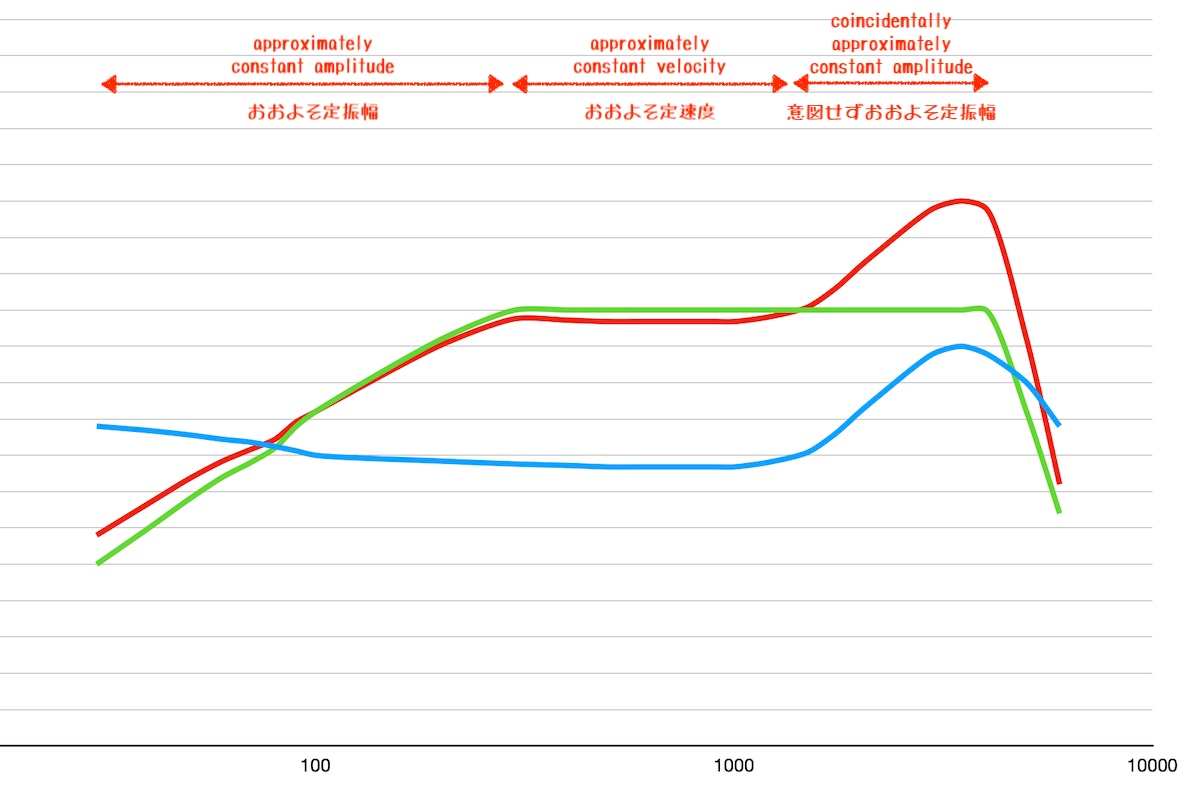
Simplified graph for better understanding (NOTE: not precise values at all): frequency responses of WE cutterhead (Green), WE condenser microphone (Blue) and total response (Red)
理解のためにイメージを単純化したグラフ(値は全く不正確ですのでご注意)。WEカッターヘッドの特性 (緑); WEコンデンサマイクの特性 (青); 合計した特性 (赤)
ここまで何度も引用している “Evolution of a Recording Curve”, R.C. Moyer, Audio Engineering Magazine July 1953, pp. 19-22 & 53-54, World Radio History website (1953)
や、
“Manual of Analogue Sound Restoration Techniques” (Copeland, 2008)
などでは、コンデンサマイクの中高域のレゾナンスピークがのちに高域プリエンファシスにつながるように示唆する記載がされています。
一方で 1926年の Maxfield & Harrison の時点では、コンデンサマイクの特性とあわせてフラットになるようにアンプが設定されたと書かれています。どのタイミングでマイクの特性が録音特性に反映されたのか(=アンプ単体でフラット特性になったのか)、は引き続き調査が必要かもしれません。
Such articles as
“Evolution of a Recording Curve”, R.C. Moyer, Audio Engineering Magazine July 1953, pp. 19-22 & 53-54, World Radio History website (1953)
and
“Manual of Analogue Sound Restoration Techniques” (Copeland, 2008)
indirectly suggests that the treble dip would be the germination of the later “treble preemphasis”.
On the other hand, the original 1926 paper by Maxfield & Harrison shows the total frequency characteristics of condencer transmitter (microphone) plus associated amplifier was completely flat. So the question “when the microphone characteristics reflected the recording characteristics (i.e. when the amplifier itself had flat frequency response)” would be one of the ongoing research target.

source: “Methods of High Quality Recording and Reproducing of Music and Speech Based on Telephone Research“, by J.P. Maxfield and H.C. Harrison, Bell System Technical Journal Vol.5, p.493-523, 1926.
1931年、RCA Victor の録音システムのマイクが、コンデンサマイクからリボンマイクに変更されます。
In 1931, RCA Victor began using ribbon microphones, gradually converting from the WE condenser microphones.
RCA Victor のエンジニア Harry F. Olson 氏 によって開発されたリボンマイクは、最初の PB-31 (1931)、44-A (1932)、44-B (1936)、44-BX (1939) など、いずれもマイクロフォンの歴史に残る名機とされますが、ついに 10,000kHz まで捉えることのできるマイクが誕生しました。
The ribbon microphones were developed by the RCA Victor engineer Harry F. Olson. From the very first PB-31 (1931), then 44-A (1932), followed by 44-B (1936) and 44-BX (1939) etc., these ribbon microphones have been highly acclaimed, and they could finally capture higher frequency range to 10,000kHz and up.
そして、WEコンデンサマイクに比べて、当時としては十分すぎるほどフラットな特性を備えていました。
The ribbon microphones also had outstanding flat frequency response for that time, compared with WE condenser microphones.
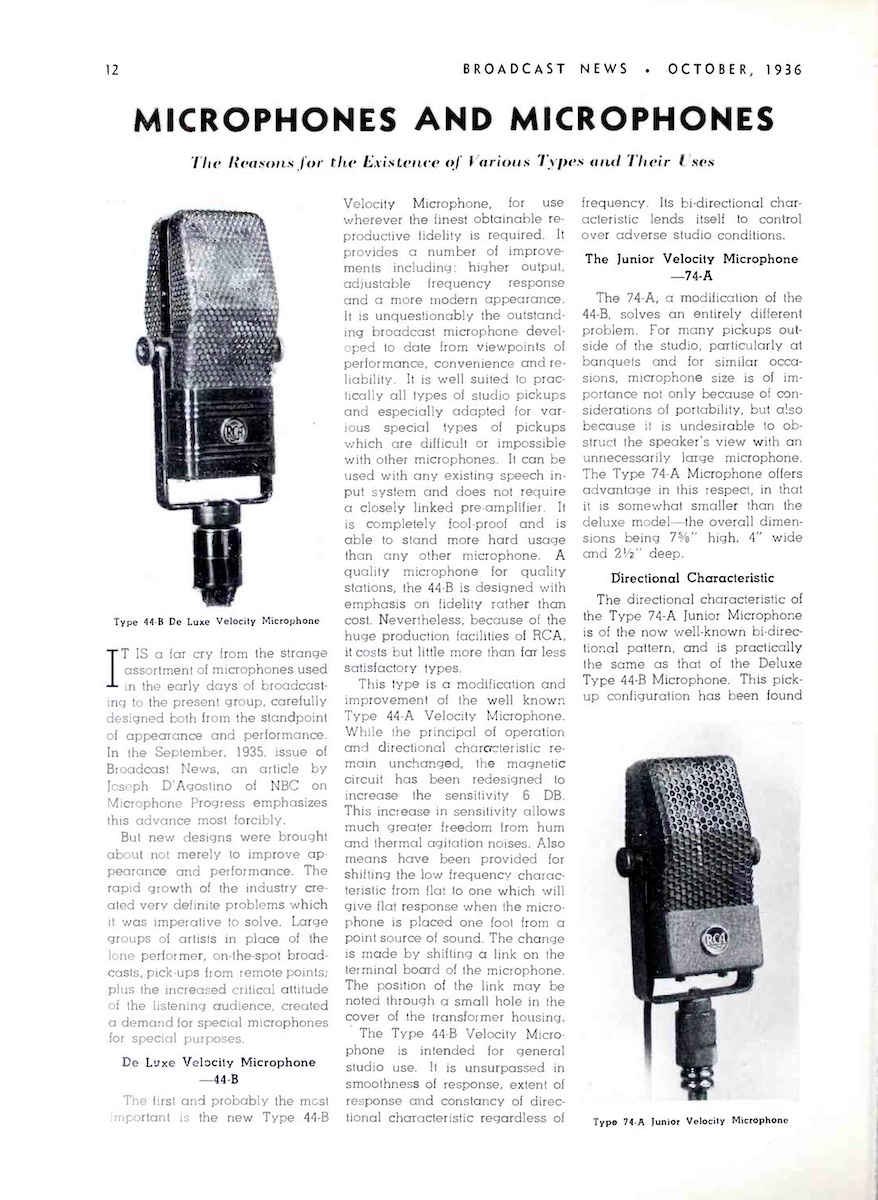
source: “Microphones and Microphones”, p.22, RCA Broadcast News, Number 22, October 1936.
1936年RCA出版の技術雑誌に掲載された、44-B 紹介記事
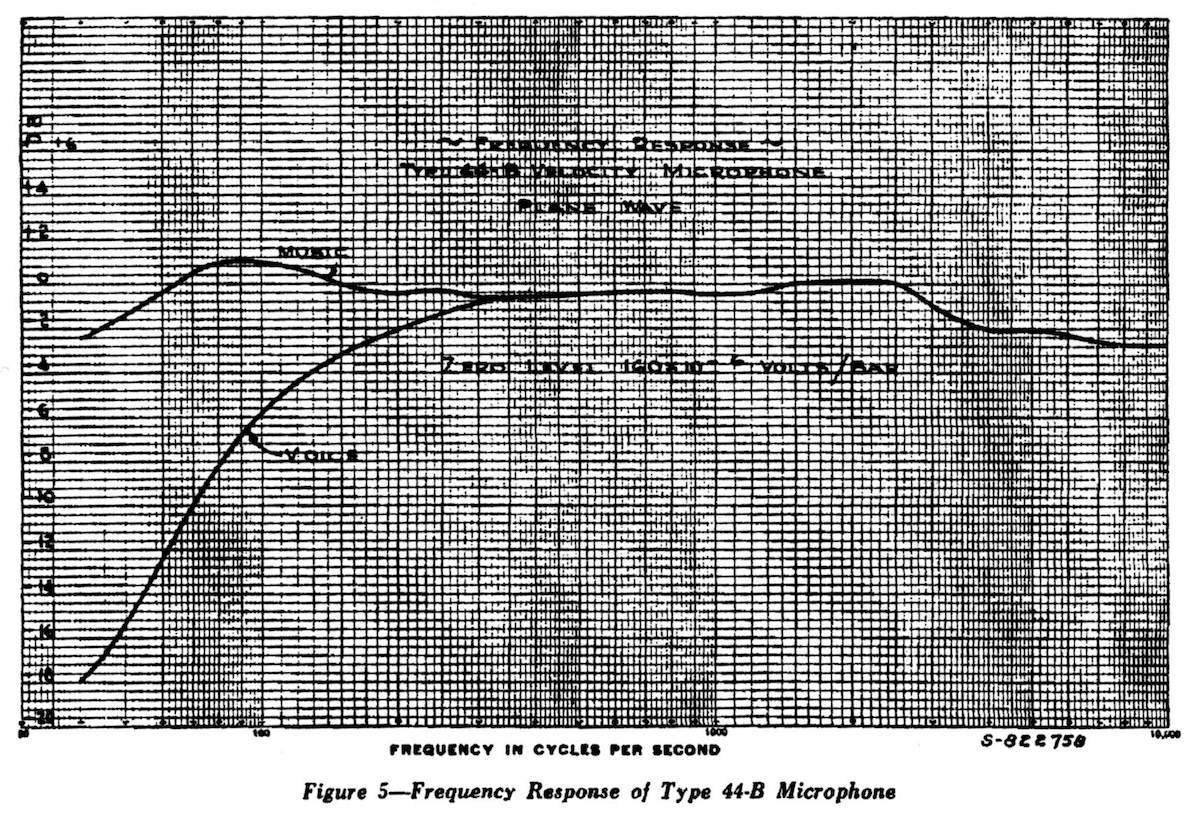
source: “Operating Instructions for Velocity Microphone Type 44-B (MI-4026A)”, RCA Victor, 1938.
44-B (MI-4026A) の 1938年取説より

source: “RCA Broaccast Equipment Catalog”, p.8, RCA Victor, 1939.
1939年RCA Victorの放送機器カタログに掲載された、44-BX の周波数特性グラフ

source: “Instructions for Velocity Microphone Type 44-BX (MI-4027-H, -J, -K)”, RCA Victor, 1956.
これは後年 (1956) の 44-BX (MI-4027-H/J/K) の取説より
3.4.5 Emulating WE microphone’s resonance peak with mic’s preamplifier
/ マイクのプリアンプでWEマイクのレゾナンスピークをエミュレート
ところが、です。このフラット特性のリボンマイクをディスク録音に使おうとした時、当初は問題があったそうです。コンデンサマイクのレゾナンスピークによって得られていた中高域の明るい音が失われたことにより、前の音の方が良かったという意見が出たそうです。 (出典: “Disc Recording Equalization Demystified (Galo, 1999)”, The LP Is Back!, p.48)
However, the thing was not simple enough. “Ribbon microphones had a much flatter high-frequency response, and consequently few people liked them as well as the condensers – many missed the presence and brilliance of the condenser mikes.” (source: “Disc Recording Equalization Demystified (Galo, 1999)”, The LP Is Back!, p.48)
また一方で、結果としてサーフェスノイズに負けないように増幅していることになるという利点が、中高域のレゾナンスピークによってもたらされている、とも認識されたそうです。 (出典: “Manual of Analogue Sound Restoration Techniques”, Copeland, 2008, p.123)
But also at the same time, “it was found that the peak of the Western Electric microphone at 2.9kHz had been beneficial in overcoming surface noise.” (source: “Manual of Analogue Sound Restoration Techniques”, Copeland, 2008, p.123)
そのため、RCAでは、リボンマイクのプリアンプに、コンデンサマイク同様の中高域特性になるようにイコライジング回路を追加して使用していたそうです。先ほども引用した、現場に立ち会っていた Frayne 氏のインタビューです:
So at the RCA Victor, electronic treble lift was added to the ribbon microphones’ preamp, in order to emulate the WE condenser microphone’s peak. Again, below is from the interview with Dr. Frayne:
When we took our new 680 (first dynamic mic) to the studios to demonstrate, no one liked the result because that peak in the middle was not there. They were used to hearing it. We put it in electronically and called it “voice effort equalization”.
(NOTE: “680” (six-eighty) in this interview could be “(Western Electric) 618A” (six-eighteen), that was introduced 8 months before RCA’s 44A)
我々がスタジオに初めてのダイナミックマイク (680) を持ち込んでデモをした際、誰ひとりその結果を好んでくれなかった。コンデンサマイクにあった中高域のピークがなくなっていたからだ。みんなあの音に慣れ親しんでいた。だから “voice effort equalization” という名前で、その中高域のピークを電気的に導入した。
(注: ここでいう “680” (six-eighty) というのは、RCA 44A より8ヶ月前にデビューした “(Western Electric) 618A” (six-eighteen) のことかもしれません)
以下のサイトでは、RCA 44-A 登場の数ヶ月前に50台ほどしか製造されなかったと言われる、貴重なリボンマイク Photophone PB-31 用のマイクプリアンプ 4PA72A1 の写真を見ることができます。
You can see the photos of RCA 4PA72A1, microphone preamplifier for RCA Photophone PB-31, the first ribbon microphone that debuted a few months before the RCA 44-A. It is estimated that only fifty units of PB-31 were made.
意図せず、のちの高域プリエンファシスと似た効果が、リボンマイクのプリアンプ部分によって実現されていたことになります。ただし、わざと中高域を持ち上げて、普通にフラットで再生されることを意図していたことになりますので、いわゆる「録音カーブ」としての中高域増幅ではないことになります。世の中に出回っている幾多のEQカーブ一覧で、初期のVictor盤のロールオフをFLATと書いているものがある理由は、コンデンサマイクのレゾナンス特性(やリボンマイクのプリアンプの高域増幅)を抜きにして、純粋なカッターヘッドの記録特性のみを尊重しているからかもしれません。
The treble lift on the ribbon microphone’s preamp (that emulated WE condenser microphone’s resonance peak) similarly contributed to the effect that was later known as “treble preemphasis”. On the other hand, the cutterhead was just recording the signal to the wax with flat (constant-velocity) characteristics above the bass turnover frequency. So we can say this treble lift is not fundamentally a part of “recording curve”. I see some of the “list of EQ curves” webpages states early Victor 78rpm as “rolloff: FLAT”, and I guess the reason they honor the cutterhead’s recording frequency characteristics, not including condenser microphone’s characteristics (and ribbon microphone’s preamp’s treble preemphasis).
同時に、そのコンデンサマイクのレゾナンス特性や、リボンマイクのプリアンプによる中高域増幅を加味して、結局 250N-6 や 250N-8 あたり(高域ロールオフつき)で再生するのがいい感じに聞こえる(そして世の中に出回っている幾多のEQカーブ一覧で、1930年代前半のロールオフを -6dB or -8dB と書いているものが多い)、というのも理解できます。この場合は、マイクの特性(マイクのプリアンプも含む)も加味した上で、再生カーブを決めていることになります(「当時の録音カーブは250N-6だった」とは異なることに注意)。当時のスピーカーでは、十分な高域まで再生できなかったというのもあるでしょう。サーフェスノイズの問題もあります。
At the same time, I understand the opinion that early Victor 78rpms should be played at “250N-6” or “250N-8” (i.e. with treble roll-off) for better reproduction. I see many of the “list of EQ curves” webpages states early Victor 78rpm as “rolloff: -6dB (or -8dB)”. In this case, we are adjusting the reproducing curve, taking microphones’ characteristics into account as well (please note that this doesn’t mean “the recording curve at the time was 250N-6”). Also, high frequency response of loudspeakers of those days were not enough, and there was a struggling with the surface noise.
About 1931, RCA invented the “ribbon microphone,” with a much more smooth and extended frequency response. However, it was found that the peak of the Western Electric microphone at 2.9kHz had been beneficial in overcoming surface noise, so it seems an electronic treble lift starting at 2.5kHz (63 microseconds) was added to emulate this, although it isn’t on Victor 84522.
1931年頃、RCA は「リボンマイク」を発明した。これはそれまでのマイクに比べて非常にスムースな特性を有し、周波数帯域も広がっていた。しかし、それ以前に使っていた Western Electric マイクにはあった 2.9kHz のピークが、サーフェスノイズ対策に効果的であることが判明したことにより、それをエミュレートするために 2.5kHz (時定数 63μs)からの高域増幅回路が追加されたと考えられる。ただし、Victor 84522 (当時のテストレコード) にはその特性は記録されていない。
“Manual of Analogue Sound Restoration Techniques”, p.123, by Peter Copeland, The British Library, 2008ここで、当記事の冒頭で紹介した Nicholas Bergh さんのコメントを再掲し、この文脈で彼のコメントを再度読んでみます。高域プリエンファシスなしで録音されていて、かつコンデンサマイクによるピーク特性があることに触れられています。
Here, in this context, I am quoting again the comment from Nicholas Bergh – the very same quote I showed far above. He makes mention of no emphasis in high frequency during the recording, with the treble peak by the condenser micrphone.
A good recording for you to hear is Robert Johnson’s Crossroad Blues in the American Epic Box. This was recorded on lacquer in the field with flat high frequency (no emphasis). It has a bit of sharpness to the recording and this is due to the peak in the condenser microphone used. It is a very different sound than typical studio recordings of the same time. There is no noise reduction except for tick removal. It was from a vinyl test pressing rather than shellac.
Kohji にぜひ聴いてもらいたいおすすめの好録音は、American Epic Box に収録されている Robert Johnson の Cross Road Blues だね。この録音は、フィールドレコーディングで、高域はプリエンファシスなしにフラットでラッカーに記録されている。録音時に使用されたコンデンサマイクのピーク特性のせいで若干シャープな音になっているけどね。この音は、同時期にスタジオ録音された音の傾向とはかなり異なっている。CDに収録した音源は、スクラッチノイズの除去以外はノイズリダクションはなにもしていない。これは、市販されたシェラック盤ではなく、テストプレスのヴァイナル盤から収録したものだ。
quoted again from the email written by Nicholas Bergh to me on Sep. 28, 2022ただし、当曲は Vocalion 03519 であり、ARC (American Record Corp.) 傘下の Vocalion レーベル(後述の通りARCは2年後にCBS傘下に)ですので、RCA Victor とは異なります。とはいえ、1930年代当時の米国の各レーベルでの記録特性は、微妙なパラメータの違いはあるにせよ、原理や仕組みとしてはほぼ同じものに則っていたと考えられます。
Please note that this recording was initially released on Vocalion 03519, a label under ARC (American Record Corp.) at that time, not under RCA Victor. As I mention later, ARC would be purchased by CBS in 1938, although many US labels in the 1930s followed the same principle and mechanism of the recording chain, with slight parameter difference among labels.
えらく長くなってしまいましたが、ともあれ、1930年代頃の RCA Victor を例にとり、ここまでに分かったことを総合すると、以下のようになりそうです。
- 当時の民生用レコード向け録音技術や民生用再生装置では、理想的なフラット再生など困難で、むしろ周波数帯域拡大が主眼で、マイクの特性も個性のように扱われていた
- マイクの周波数特性と、カッティング機材の周波数特性の合計が、結果として録音カーブのようになっていた
- ただし、録音スタジオごと(フィールドレコーディングの場合は持ち込み機材ごと)に使われていた録音機材やマイクはそれぞれ異なっていた可能性が高い
- マイクのレゾナンスピークのある音が好まれたということは、本来はそのピークを補正せずに聴くのが録音者の意図に合っていることになる、とも言える
- 一方で、どうやら中高域増幅がサーフェスノイズ対策になることが分かり、のちに意図的に中高域での増幅が行われるようになったので、そのピークを補正して聴くのも意図に合っていると言える(ただし現代のフォノEQでの正確な補正は困難)
Well, it took longer than I thought, and we have come too far… Anyway, if I rougly summarize what I have learned so far from RCA Victor in the 1930s, it would be something like this:
- perfect “flat” recording/reproducing was not possible with the technology (i.e. recording technology for consumer disc records and playback equipment for consumers) at that time. Engineers rather intended the extention of the recorded/reproduced frequency range; and microphone’s frequency characteristics was regarded as individuality and warmth
- Old microphone’s frequency characteristics unintentionally contributed the treble preemphasis that later became an integral part of recording EQ curve
- Recording equipments including micrphones highly probably varied among recording studios (and equipments for field recordings)
- After reading the story like “people prefered brilliant sound of the condenser microphones”, we can say that it is correct (in a sense) to ignore microphone’s characteristics for compensation (playback equalization)
- On the other hand, people noticed such treble lift was beneficial in overcoming surface noise. So sometime in the 1930s “treble boost” gradually became a part of recording curve, intentionally: in this sense, it is also correct to compensate treble boot for playback (but the precise compensation is almost impossible with phono preamplifiers we have today)
つまり、繰り返しになりますが、現代のようにターンオーバー/ロールオフを簡便に切り替えられる時代とは、全然異なっていたということです。
That is to say, like I noted too in my previous article (Pt.1), it was more complicated and still “the development in progress” in these days, unlike we fine-tune the playback EQ curve by rotating “turnover” and “rolloff” knobs very easily on the reproducing component(s).
少なくとも、民生用レコードについては、現代のように録音再生カーブとそのパラメータが厳密に規格として決められていたわけでは全くなく、当時の技術資料、実際のレコードに残る音、テストレコードの周波数特性などを総合的に判断して、今でいう「ターンオーバー」「ロールオフ」をどの値にすれば、おおよそいい感じで再生できるか、というだけになります。
At least, for consumer disc records, it was the days when recording/reproducing characteristics was NOT strictly standardized with associating parameters like it is now. We are just experimenting the “turnover” “rolloff” reproducing parameters that likely to get “more desirable” better playback, according to the historical technical documentations, the sound on the historical records, frequency responses of surviving test records from these years, etc.
つまり、LP初期〜現代のプリアンプやフォノイコに搭載されている「ターンオーバー」「ロールオフ」の設定をどんなに頑張っても、1920年代〜1930年代当時の録音カーブ用の再生カーブを「完璧に」作ることはそもそも無理だ、ということです。
In other words, the reproduction of electrically-recorded shellac discs in 1920s〜1930s cannot be strictly/precisely obtained even with the fine-tuning “turnover” and “rolloff” settings on the preamplifiers of early LP era to those of modern era.
78rpm コレクターかつオーディオ機器復刻マニアの Roger Robles さん (Prozoot) が、調査に基づいた完璧な再生カーブで新品同様の 78rpm を再生したであろう音源を公開されている YouTube 動画が、1930年代前半とは信じられないほどびっくりするほど素晴らしい音で鳴っています。この方は、78rpm の CD 復刻のエンジニア もされています。
以下の例は、RCA Victor の廉売用レーベル Bluebird からリリースされた、1933年12月5日シカゴ録音の Ted Weems Orchestra のゴキゲンなダンスナンバー “Sittin’ Up Waitin’ For You” ですが、周波数帯域が狭めで、後半(内周部分)で若干歪みが感じられる以外は、実に生々しい再生となっています。
The YouTube account Prozoot, maintained by Roger Robles, who is a well-known 78rpm collector and an audio restoration geek (also an engineer for CD reissues of 78rpm music), presents many high quality 78rpm reproductions – it doesn’t sound like it was recorded in the early 1930s at all – highly probably as a result of dedicated research for the most appropriate reproduction EQ curves, and with near-mint copies of vintage 78rpms.
The below example is a nice dance number “Sittin’ Up Waitin’ For You” by Ted Weems Orchestra, recorded in Chicago, IL, Dec. 5, 1933, released from Bluebird label (a budget subsidiary of RCA Victor). It sounds very fresh, live and like new, although the frequency range is narrower than that of today, and a bit distortion being heard at the latter part.
比較用として、DAHR (Discography of American Historical Recordings) で公開されているトランスファーも置いておきます。
For comparison, below is the transfer by DAHR (Discography of American Historical Recordings).
3.5 Columbia System…???
RCA Victor と並ぶメジャーレーベル Columbia ですが、録音機材や特性についてはわからないことだらけです。とにかく RCA Victor 以上に歴史がややこしいのです。
As for the recording equipments used by the other major label Columbia in the 1930s, I couldn’t find enough information so far – the history of Columbia is much more complicated than that of RCA Victor.
というのも、元々 1889年にワシントンDCで設立された Columbia Phonograph 社が、英国の子会社として Columbia Graphophone Manufacturing 社を管理、のちにこれが Columbia Gramophone 社という名で英国企業として登記、しかし市場の低迷による経営悪化で1922年に米Columbiaは管財人の管理下に入り、12月に英国子会社を売却します。
To start with, the Columbia Phonograph Company was founded in Washinton DC, 1889. The company managed a UK subsidiary, the Columbia Graphophone Manufacturing Company, later became the Columbia Graphophone Company and registered as a British company. However, due to the market downturn and poor sales, US Columbia went into receivership in 1922. In Dec. 1922, US Columbia sold the UK Columbia Graphophone Company.
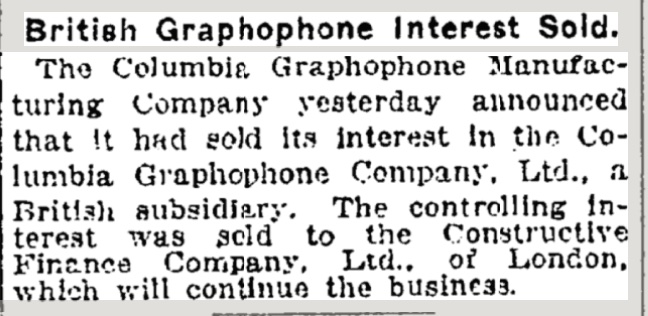
source: “British Gramohpone interest Sold.”, The New York Times, December 13, 1922, p.32.
それでもラジオの勃興もあり財政状況が好転しない米Columbia社 (Columbia Phonograph Company, Inc.) が、Bell Labs / Western Electric 社の電気録音システムを使いたいが特許使用料を払える状況でなかったところ、英国でも電気録音を利用したい英Columbia社が、元親会社の米Columbia社を1925年に買収します。
US Columbia emerged from receivership as Columbia Phonograph Company, Inc., but booming radio sales still impacted the company. In order to pay the royality for Bell Labs / Western Electric recording system, British Columbia Graphophone Company acquired the US Columbia Phonograph Company in 1925 – that enabled British Columbia use the Bell/WE electric system in the UK.
In addition to its purchase of the American branch of the Company (it’s original parent company) in 1925 as part of the licensing negotiations with Western Electric for the use of the new electrical recording system, it went on to buy the U.S. General Phonograph Corporation, the producer of the Okeh label, and many other foreign companies active in different territories: (..omitting the rest…)
1925年、Western Electric社の新しい電気録音システムの利用ライセンス交渉の一環として、米Columbia(元親会社)を買収したことに加え、翌年の米General Phonograph社の買収へと続いた。このGeneral Phonograph社は、Okehレーベルを所持しており、また世界中の多くの外国企業の権利も保持していた(…以下省略…)
“The Columbia Graphophone Company, 1923-1931: Commercial Competition, Cultural Plurality and Beyond”, David Patmore, Musicae Scientiae, 14, pp.115-137, 2010さらに、1929年からの大恐慌による世界的大不況の中、1931年に英Columbia社はOdeonやParlophoneと共に、Gramophone (HMV) 社に吸収合併され、Electric and Musical Industries (EMI) となります。
Furthermore, the Great Depression since 1929 led to huge losses in the regording industry in general, In 1931, British Columbia Graphophone Company (as well as Odeon and Parlophone) merged with the Gramophone Compnay (HMV) to form the Electric and Musical Industries, Ltd. (EMI).
ところが、Gramophone (HMV) 社は 1921年以降 Victor Talking Machine社(すなわち後の RCA Victor社)の子会社化しており、RCA Victor社がライバルの米Columbiaも傘下に収めることになってしまうので、米国の独占禁止法に抵触しないよう、EMI社は米Columbia社を銀行グループに議決権信託します。さらに1932年、米Columbia社はGrigsby-Grunow社に売却されます。
However, Gramophone (HMV) was a wholly owned subsidiary of Victor Talking Machine (then RCA Victor), and the US Columbia was a subsidiary of British Columbia – this meant the RCA Victor would own the rival. So the EMI sold off US Columbia in 1931, in order to avoid antitrust law. Then in December 1931, Grigsby-Grunow Company acquired US Columbia.
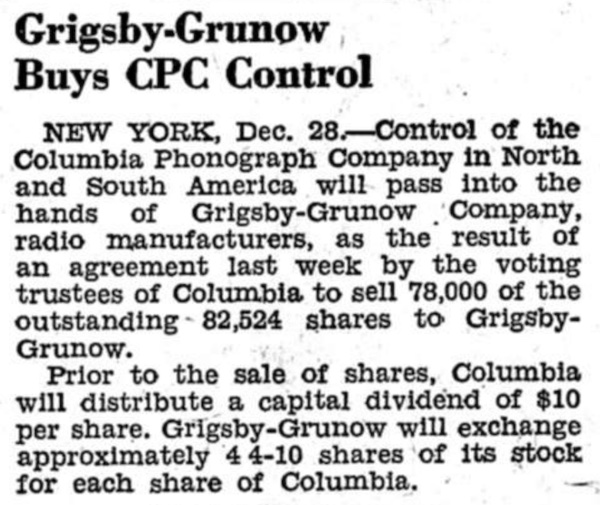
source: “Grigsby-Grunow Buys CPC Control”, , The Billboard, p.4, January 2, 1932.
1931年12月28日の情報として、Grigsby-Grunow社による米Columbia社の買収を報じる記事
大恐慌による不景気が続く中、今度はその親会社であるGrigsby-Grunow社が1933年破産管財人の管理下に入ってしまい、American Record Corp (ARC) 傘下となります。この ARC は、1931年4月に Brunswick を買った Warner Bros. 社から音源リリース権を取得していました。
Still in the Great Depression, US Columbia’s parent company Grigsby-Grunow went into bunkruptcy in 1933 – US Columbia was sold in 1934 to American Record Corp (ARC). ARC had the right to lease Brunswick masters from Warner Bros.. Warner Bros. already acquired Brunswick Records in April 1930.

source: “Warner May Sell Unit.”, The New York Times, November 13, 1931, p.35.
今度は1938年12月17日、Columbia Broadcasting System (CBS) 社が ARC を買収します。CBS は元々米Columbia社から1927年に分離独立した会社 “Columbia Phonographic Broadcasting System” でした。
Then on December 17, 1938, ARC was purchased by the Columbia Broadcasting System (CBS), that originally was Columbia Phonographic Broadcasting System established in 1927, invested by US Columbia.
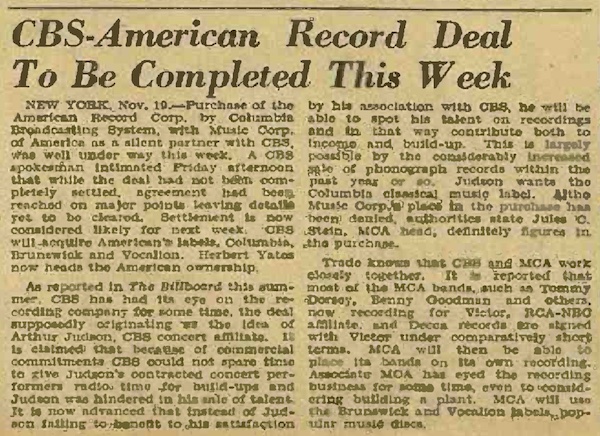
source: “CBS-American Record Deal To Be Completed This Week”, , The Billboard, p.5, November 26, 1938.
1938年11月11日の情報として、Columbia Broadcasting System社による American Record Corp. 買収交渉を報じる記事
ともあれ、ここに至り、やっと米Columbiaが本格的な復活を目指すことができるようになります。なお、Brunswick (及び Brunswick が 1924年に買収した Vocalion) の音源は、1931年12月以前のものは米Decca(1941年に Warner から Brunswick を買取)に、それ以降のものは CBS/Columbia に権利が分けられました。
After all, CBS’s acquisition of US Columbia finally enabled the Columbia label getting very active again like it used to be. All Brunswick (and Vocalion, which Brunswick bought in 1924) masters were sold to American Decca, and CBS/Columbia kept the rights to recording from late December 1931.
… ふぅ、とても一筋縄ではいかない歴史ですね。綺麗に整理するのは難しすぎます(笑)
… Whew, it is really not an easy history at all – it’s really tough to organize and sort the history beautifully. I wish I could someday.
ともあれ、こんな激動の時代ですから、(内部の)技術資料が満足に残っているわけもなく、当時の米Columbia社がいつまで Bell Labs / Western Electric 録音システムを使っていたのか、それ以後どのような録音機材を使っていたか、などの裏付けはほとんど出来なさそうです。どなたかこの辺について書かれた資料やインタビューをご存知の方がいらっしゃたら教えてください(笑)
Above all, it was such a turbulent period, and few technical (internal) documents survive or surface. So it still is a question – until when the US Columbia used the Bell Labs / Western Electric recording system, and what kind of recording equipments they used after that. If anyone know the existence of such documents or interviews, please let me know!
ただ、US Columbia において、Bell Labs / Western Electric 製ラバーラインレコーダでカッティングされたレコードには「Ⓦ」(丸の中にW) の刻印が施されている、という点だけは記しておきます。
There’s one thing worth mentioning: US Columbia discs that were cut with Bell Labs / Western Electric “rubber-line” recorder has the stamped matrix Ⓦ (W in a circle).
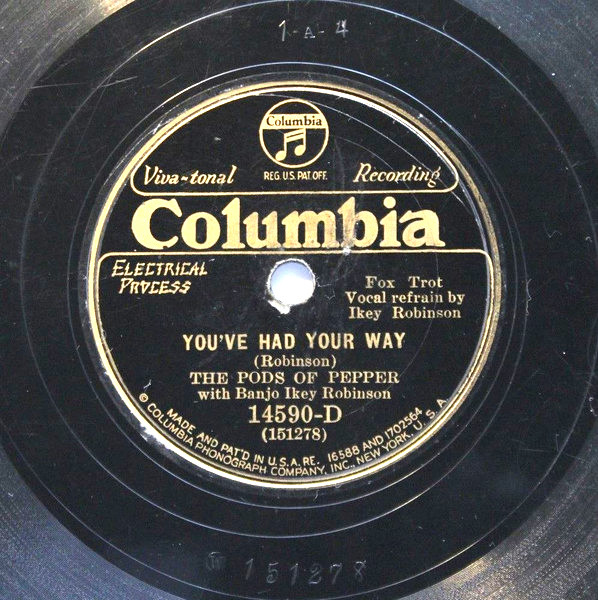
source: Columbia 14590-D (1931), retrieved from Discogs.
1931年の US Columbia 78rpm の例。マトリクス番号 151278 の前に Ⓦ の刻印があり、これが WE ラバーラインレコーダでのカッティングを意味する
以下の映像「How a Columbia record is made 1928 (Parts One & Two)」では、1928年の Columbia の録音風景が見られますが、WE ラバーレコーダが使われているのが確認できます。というか指揮者は Stravinsky ですね(笑)
The following video “How a Columbia record is made 1928 (Parts One & Two)” captures the Columbia’s recording session in 1928 – you see the WE rubber-line recorder in motion. Also the conductor is Stravinsky! 🙂
ひとつだけ興味深いこぼれ話を。
1938年、米Columbia が CBS 傘下となったほぼ同時期、Columbia 社長の Edward Wallerstein 氏が RCA Victor の Program Transcription (次回に解説します)のアイデアを元に、マイクログルーヴLPの研究開発を開始します。
そもそもこの Wallerstein 氏は、1933年から1938年まで RCA Victor の幹部だった人で、1935年〜1936年にはすでに RCA でマイクログルーヴ録音の研究に従事していた、というのです。そもそも、1933年に Program Transcription の市場からの撤退を指揮したのがこの Wallerstein 氏でした。そして CBS による Columbia の買収のタイミングで、Columbia に引き抜かれます。
つまり、第二次世界大戦の中断を経て、1948年に Columbia から発表された Long Playing Microgroove Records (LP) のアイデアの発端は、RCA Victor の研究だった、ということになります。この辺りはまた続編で触れることにしましょう。
One interesting tidbit here.
In 1938, soon after CBS took over Columbia, president Edward Wallerstein started research development of microgroove Long Playing records, with the idea originated by RCA Victor’s Program Transcription (that will be featured in my next article Pt.4).
Surprisingly, Mr. Wallerstein was an executive with RCA 1932 through 1938, and his team was responsible for researches on microgroove recording at RCA. Also, Mr. Wallerstein was the man who directed taking Program Transcription off the market. He moved from RCA Victor to Columbia just after CBS took over Columbia.
So, Columbia’s Long Playing Microgroove Records (LP), premiered in 1948, started with the idea originated from the research development at RCA Victor. I think I will deal with these episodes again in my following articles.
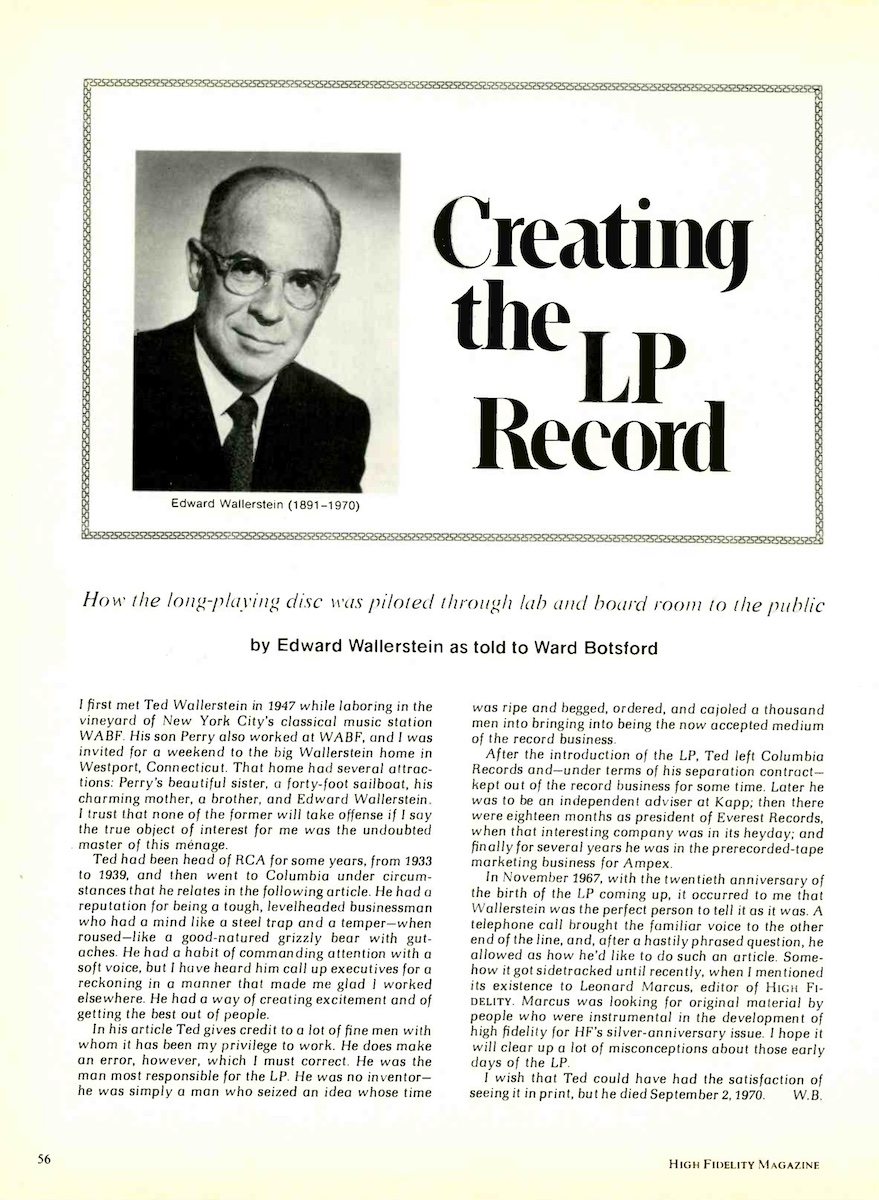
source: “Creating the LP Record”, by Edward Wallerstein as told to Ward Botsford, High Fidelity Magazine, pp.56-61, April 1976.
High Fidelity 誌 1976年4月号に掲載された、Edward Walerstein 氏への 1967年インタビュー(氏は1970年に逝去)
3.6 New Recording Chain
時代が進むにつれ、恐らく1930年代後半〜1940年代前半頃、「民生用レコードの世界でも」録音可能な周波数帯域がどんどん上に広がると同時に、電蓄のピックアップの技術向上も進んだ頃、記録可能な高域上限まで定速度のまま記録するのではなく、ある周波数帯域から上を再び定振幅で記録する試みが各社で行われはじめたようです。
As time went by, and as technology advanced, extending the high-frequency response of the recording became reality “for the disc records of the consumer market as well” – probably sometime in the late-1930s or early-1940s – , along with the technological improvement of the reproducers (phono pickups), some companies might start experimenting with “recording higher frequency range in constant amplitude”, instead of keeping the constant velocity characteristics up to the highest possible frequency.
「ようです」と書いたのは、いつ、どのレーベルのどのエンジニアが、どんな機材を使って、それを行ったのか、そういった試行錯誤の歴史が記録された技術資料を見つけられない(あるいはほとんど残っていない、はたまた公にされていない)からです。先述の通り、レコードや蓄音機の売り上げは依然ラジオに押され、しかも大恐慌時代ですから、研究開発投資がラジオなど通信技術(と来るべきテレビ)に向けられていたこともあるでしょう。
The reason I wrote “some companies might start experimenting” instaed of “some companies started experimenting”, is because it is virtually impossible to identify when, which engineer of which label, applied constant amplitude to high frequencies, with which components and instruments during these period – few technical documents and articles exist (or I could not find them, or even not disclosed public), that would be great help of shedding light on the history of “trial-and-error” experimentations. Like I have written above, radio craze resulted in poor sales of phonograph players and discs, and the Great Depression – most of the investment was mainly for radio, telecommunications, and coming television systems.
ともあれ、これが、民生用において、高域トランジション周波数 (treble transition frequency) と 高域プリエンファシス (treble preemphasis) が意識された始まりということになります。
Anyway, we could say that this was the germination of treble transition frequency and treble preemphasis of discs for consumer market.
民生用の RCA Victor の場合はどうだったか、というと、実質的な記録上限が4,500〜8,000Hz だった頃は、上で触れた「コンデンサマイクのレゾナンス特性」や「リボンマイクのプリアンプでそれを模したイコライズ」が、結果として高域プリエンファシスの役割を果たしていたのかもしれません。
As for RCA Victor’s records for commercial market, when the upper limit was 4,500kHz to 8,000kHz, “resonance peak of condenser microphones” and “treble boost in the ribbon microphone preamplifiers” would later become treble preemphasis as a result (or not).
1938年(これには諸説あるようで、後述の通り Copeland 氏 はもっと早かった可能性を示唆しています)に RCA Victor は、リボンマイクのプリアンプのイコライズを外し、カッターヘッドを駆動するパワーアンプの直前に移動しました。これにより、高域プリエンファシスが録音カーブの一部になったとみなすことが出来るようになった、と言えるのかもしれません。
It is said that in 1938 (several opinions exist, including Mr. Copeland coins the possibility it took earlier than 1938) RCA Victor removed the high-frequency boost from the microphone preamps, then added the equalization circuit just before the power amplifier that drived the cutterhead. With this new recording chain, we could say the treble preemphasis became the part of the recording curve.
以下の引用は、Audio Engineering 誌 1953年7月号に掲載された、RCA Victor の R.C. Moyer 氏による有名な解説記事 “Evolution of a Recording Curve” 内に書かれているものです。
The following quote is from the famous article “Evolution of a Recording Curve” by R.C. Moyer of RCA Victor Division, published on the Audio Engineering magazine July 1953 issue.
In 1938 the improved RCA version of the wax recorder and completely new and improved recording channels were placed in operation. At that time the adjustable bass filter was discarded, pre-emphasis was removed from the preamplifier and added after the recording bus, and an 8,500-cps low-pass filter was added primarily to reduce noise and distortion effects resulting from playback turntable flutter, pickup tracking, and manufacturing methods. The recording characteristic then became that of Curve C, Fig. 4.
1938年、RCAによる改良型(Western Electric)ワックスレコーダと全く新しく開発された改良版録音チャンネルが稼働を開始した。この際、調整可能な低音フィルタが撤廃され、プリアンプからプリエンファシスが外され、録音バスの後ろに移動した。さらに、8,500cps(Hz)のローパスフィルタを追加したが、これは再生時のフラッター、ピックアップのトラッキング、製造方法などに起因するサーフェスノイズや歪みを減らす目的であった。この結果、録音特性は図4のカーブCのようになった。
Evolution of a Recording Curve, R.C. Moyer, Audio Engineering magazine, July 1953, p.21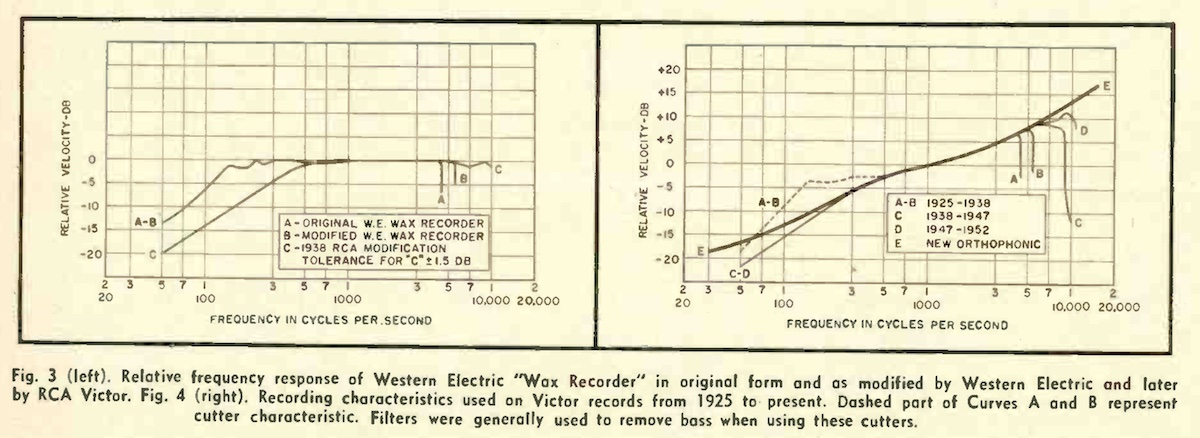
source: “Evolution of a Recording Curve”, by R.C. Moyer, Audio Engineering Magazine, July 1953, p.20.
ただし、先述した通り、Copeland 氏はこの Moyer 氏の執筆した記事で解説された史実の正当性に疑義を唱えていることには留意が必要 です。
However, it should be noted that Peter Copeland (author of “Manual of Analogue Sound Restoration Techniques” raises a doubt over historical evidence described in the Moyer’s article.
…However, Moyer (Ref. 11) is not very clear about the chronology; according to him, it wasn’t until 1938 that the entire chain from microphone to pick was changed. (He makes other mistakes about chronology)…
…We know that by 1943 RCA were selling their own wide-range cutterhead; but Moyer is adamant that Western Electric equipment, still working on the same principles, was upgraded yet again “about 1947”;…
…Moyer points out that when standardisation of all RCA Victor records was attempted in 1938, a 6dB/octave slope below 500Hz (318 microseconds) was usually found to be satisfactory for most older records. This writer agrees for post-1932 RCA Victor records, and the assertion is almost identical to the evidence of Victor 84522; but it is probably an oversimplification for earlier Victors…
…しかし、Moyer (Ref. 11) はクロノロジーについてはあまり明確にしていない。Moyer氏によると、マイクからピックアップまでのチェーンが変更されたのは1938年であったとされる(彼は他にも史実年表的な間違いを犯している)。…
…RCAが、自社製のワイドレンジカッターヘッドを遅くとも1943年には製造販売していたことが確認されているが、Moyer氏は、RCAは引き続き Western Electric システムで録音し続けたと頑固に主張している。しかも、「1947年に」再度アップグレードされた、とも。…
…Moyer氏は、RCA Victor の録音カーブの標準化が社内で試みられたのは1938年であったと指摘している。それは 500Hz (時定数 318μs)以下で 6dB/オクターブの傾斜となっており、ほとんどの古い盤について満足のいくものであった、という。筆者(Copeland氏)としては、1932年以降の RCA Victor の盤については同意見であり、先述した当時のテストレコード Victor 84522 という証拠とも合致する。しかし、1932年より前の Victor のレコードについてもこれを当てはめるのは、あまりにも議論を単純化しすぎであろう。…
Manual of Analogue Sound Restoration Techniques”, Copeland, 2008, p.123ところが、民生用ではなく、プロ用(放送局用)の世界では、それよりも早く高域プリエンファシスが意識的に使われていた のです。
But discs for consumers are not the only disc records during these years. As a matter of fact, intentional “treble pre-emphasis” was already used for professional use for broadcast stations.
ここから先の話については、次回以降で扱うことにします。
The following topics and stories will be covered in my coming articles.
3.7 The summary of what I got this time / 自分なりのまとめ
今回も予想以上に長くなってしまいました(笑)。ラジオの脅威、大恐慌時代のレーベル存亡危機などを超えて、高域プリエンファシスの萌芽が見られる辺りまで書きました。先述の Galo 氏の論文にある、以下のイラストの世界まで、あともう少しです。
Well, in this Part 3 article (again, it became a way longer than I initially intended…), I have learned so many things about the radio craze affecting phonograph industry; label crisis during the Great Depression; and the early sign of treble preemphasis. As technology advanced, the world of modern “equalization curve”, like shown in the illustration from the famous G.A. Galo’s article, was coming just a few steps ahead.
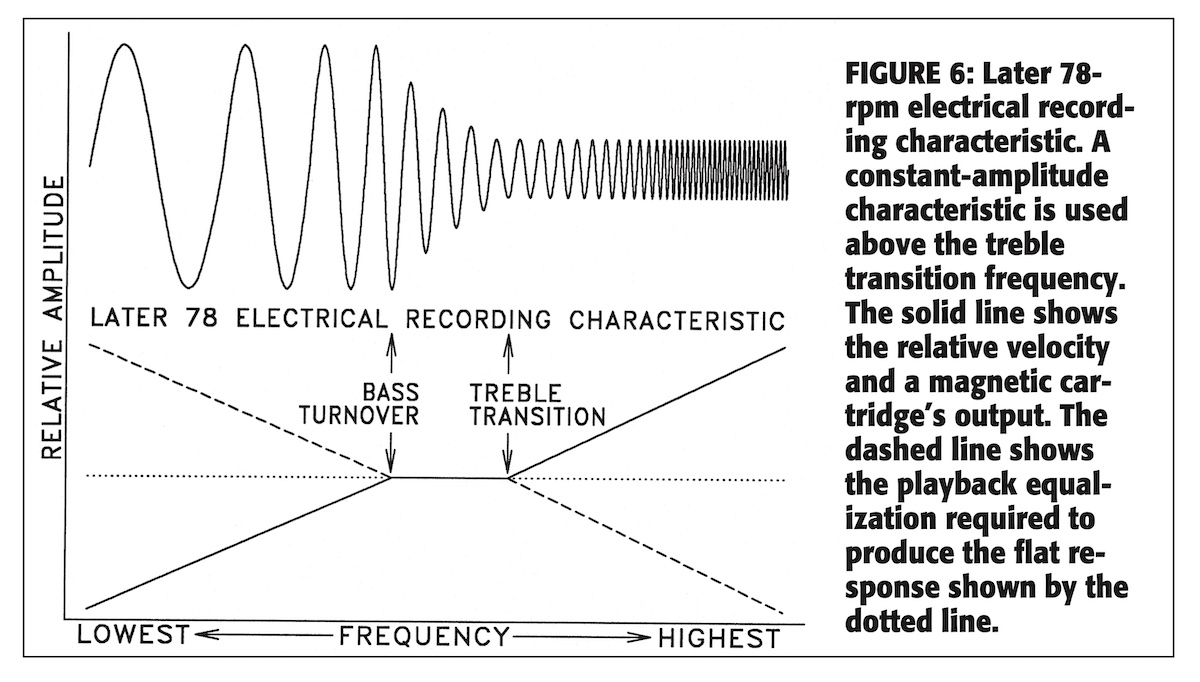
source: “Disc Recording Equalization Demystified”, The LP Is Back!, p.45-54, audio express website (1999)
ベースターンオーバー周波数に加え、高域トランジション周波数も登場した場合の録音カーブ(実線)
低域ターンオーバー周波数より下と、高域トランジション周波数より上が定振幅、間が定加速
点線が再生カーブに相当する
さてさて、今回の内容をざっくりまとめると、こんな感じでしょうか。
…so, the rough summary of my understanding in this article would be something like this:
Bell Labs / Western Electric のラバーライン録音システムの特許使用料が高かったため、特許を回避した独自録音システムが生まれていった。その中で最も重要な、現代につながる発明は、英Columbia (後の英EMI) の Blumlein が開発した録音システムであった。
Many companies tried to invent electrical recording systems that did not infringe the Western Electric’s patent. The most important development was the system invented by Blumlein of GB Columbia (later GB EMI).
RCA Victor は引き続きラバーライン録音システムを改良し使い続けたが、マイクの開発が進むにつれ、当初のWEマイクにあった中高域が持ち上がった特性に注目し、ディスク録音における中高域のプリエンファシスの重要性が徐々に認識されていった。これがのちに民生用レコードにおける録音カーブの一部となった可能性がある。
RCA Victor continued using and improving the Rubber-line recording system. As the microphone technology improved, treble lift (that originally derived from WE microphones’ characteristics) caught their attention. Later it (highly probably) could lead the germination of the later “treble preemphasis” of the recording EQ curve for consumer disc records.
WEマイクによる中高域特性(のちにRCAリボンマイクのプリアンプによる中高域増幅)を、録音カーブとしての中高域プリエンファシスとみなすと、高域を補正して再生するのが正しいといえる。一方で、マイクやプリアンプによる中高域増幅の音が好まれていた、という意味においては、高域はフラットのまま再生するのも正しいと言える。
WE microphones’ treble boost can be regarded as an intentional treble preemphasis (as a recording EQ curve) – in this sense, it would be correct to play such records with treble compensation. On the other hand, as people prefered WE microphone’s sound with treble boost (later boosted by RCA ribbon microphone’s preamp) at that time, it would also be correct to play such records with “FLAT” (no treble compensation).
民生用(市販用)のレコードと、プロフェッショナル向け(主に放送局用)のレコードは、当時は求められる厳密さ(録音時の特性、再生機器の特性など)が全く異なっていた。次回に触れるが、高域プリエンファシスを意図的に行ったのは、放送局用トランスクリプション盤が先であった。
Commercial disc records (for public) and Professional disc records (for broadcast stations) are very different in terms of required strictness (recording characteristics, frequency response of playback equipments, etc.): Electrical transcription discs for broadcast station was the first example of the application of the intentional treble preemphasis, as I will mention in the next part of the article.
次回は引き続き歴史を辿り、ラジオ局向けトランスクリプション盤の誕生、Bell Labs 縦振動録音システムの技術革新あたりについて学んでいきます。
My next post will feature the continuing history, including the Electrical Transcription for radio stations, the innovation of Bell Labs’ vertical recordings system etc..
» 続き / Sequel: “Things I learned on Phono EQ curves, Pt.4” »
余談
以下の「20世紀的脱Hi-Fi音響論(延長13回裏)」というページで、1920年代〜1940年代のラジオ、Presto アセテート録音機、リボンマイクを発明したOlson氏の活躍、Lancing社のスピーカ、当時のアンプ、についての非常に興味深い記事を読むことができます。

